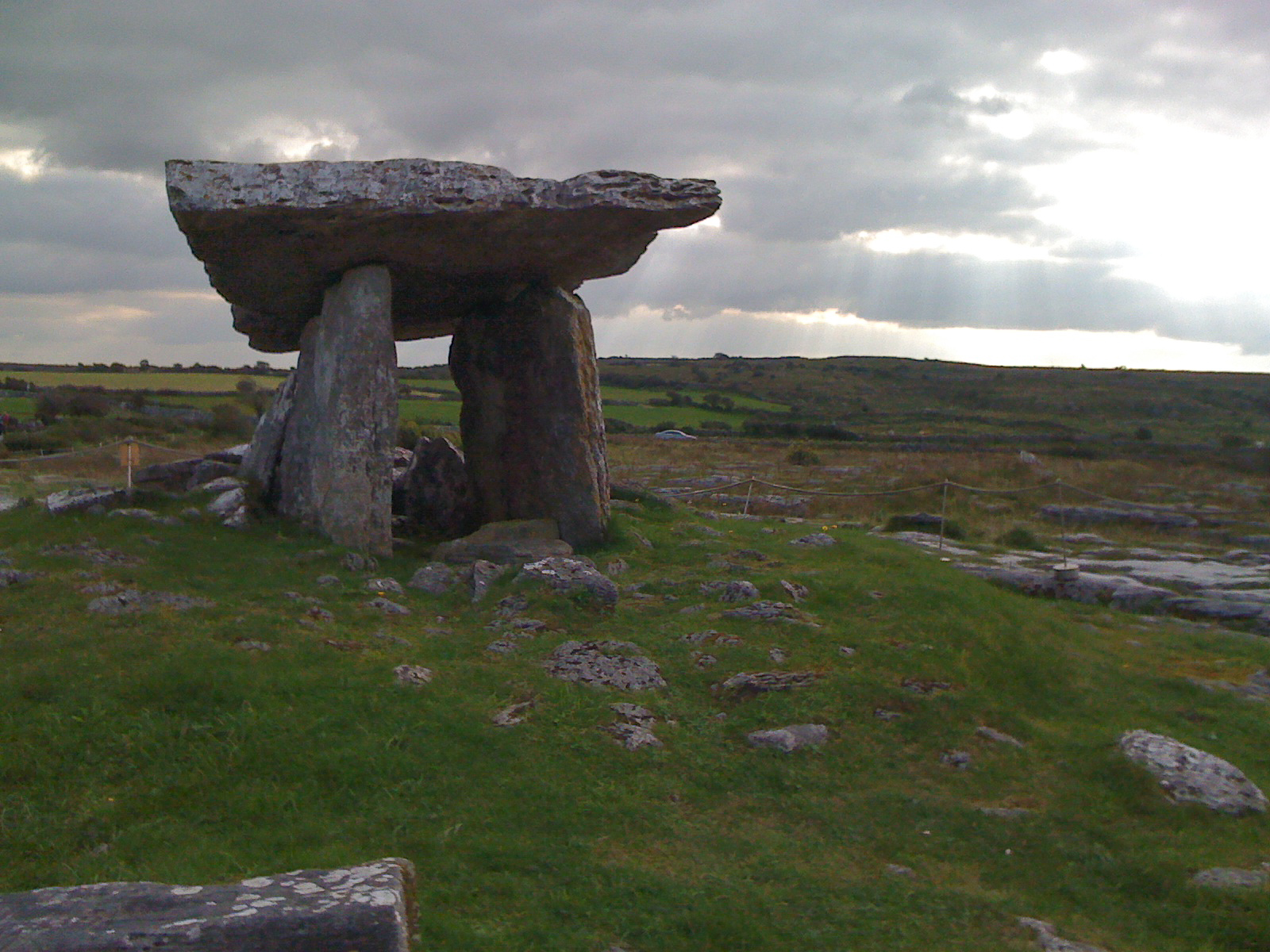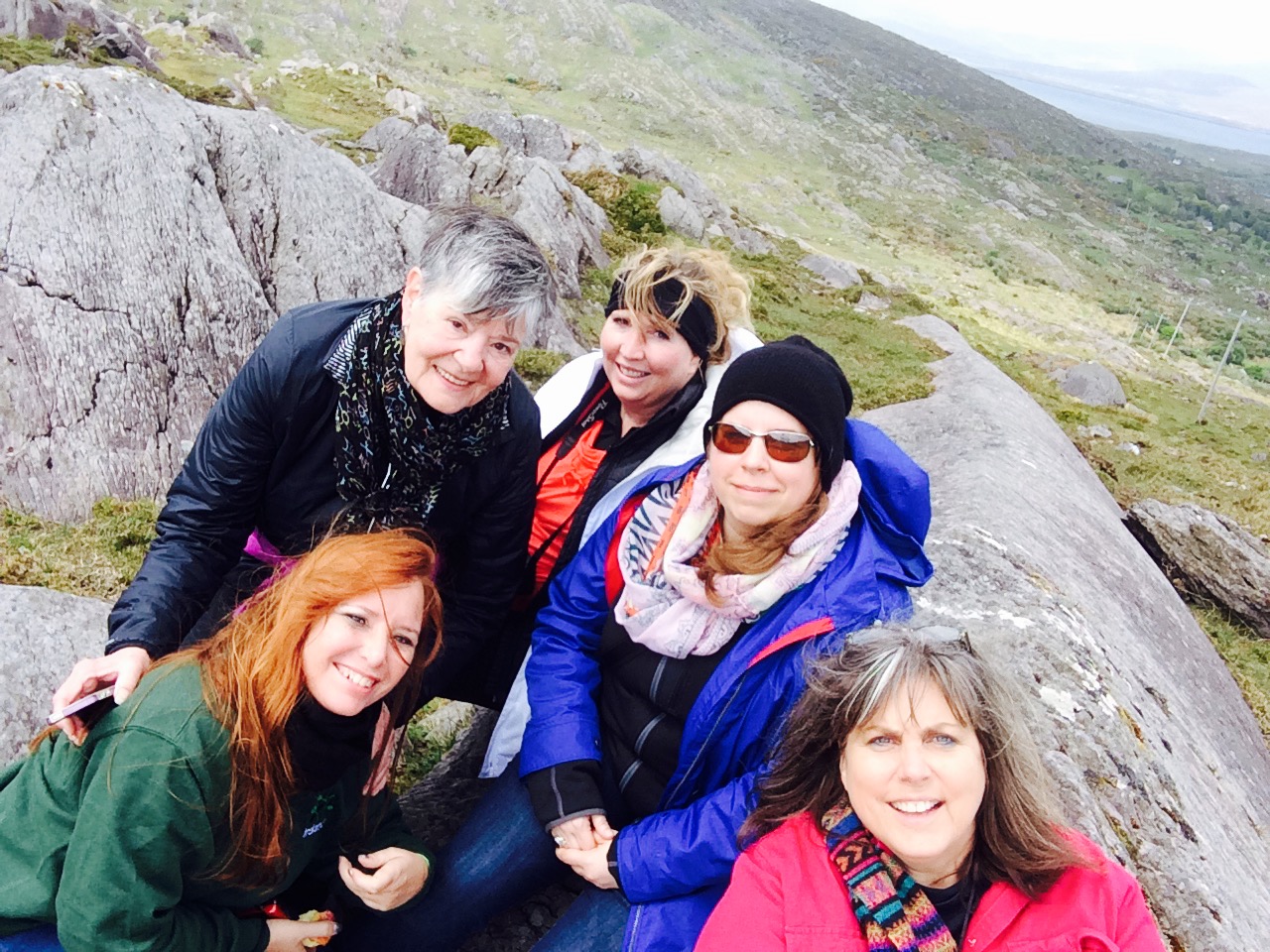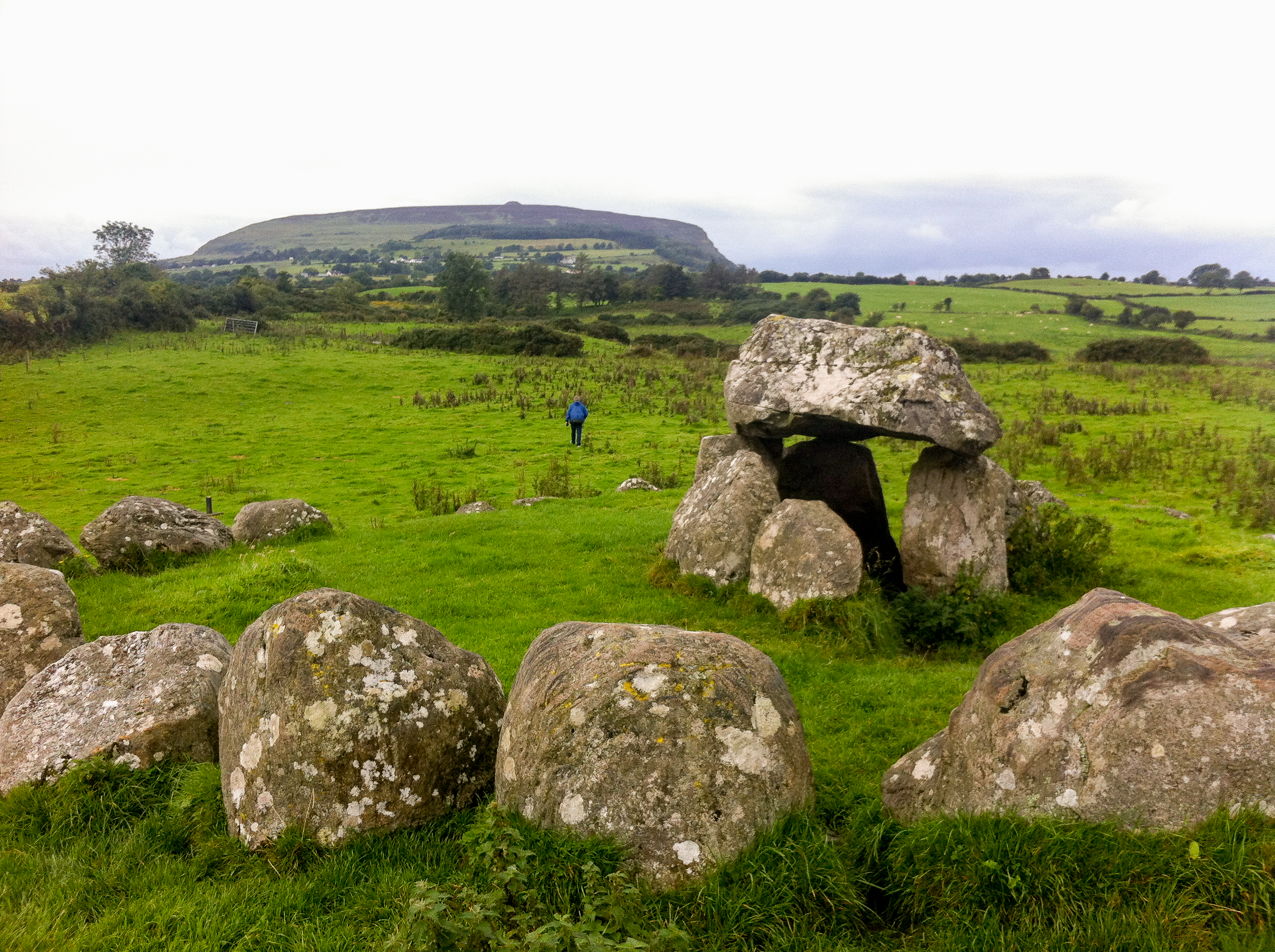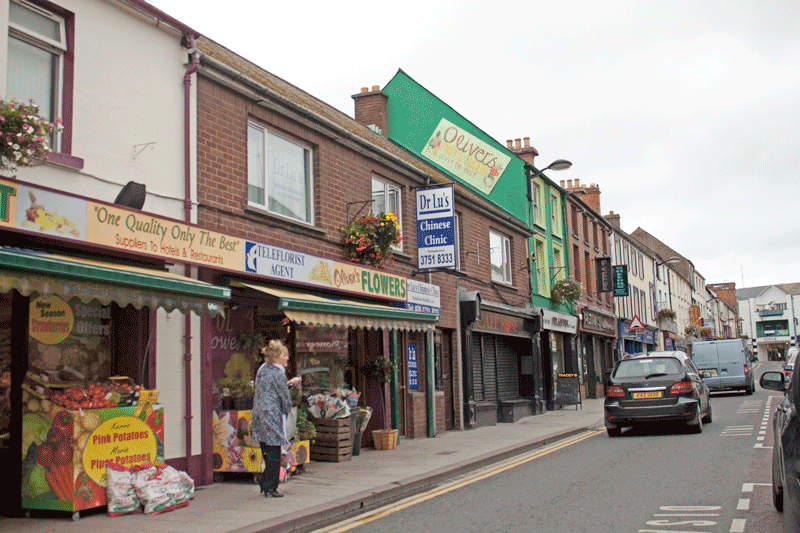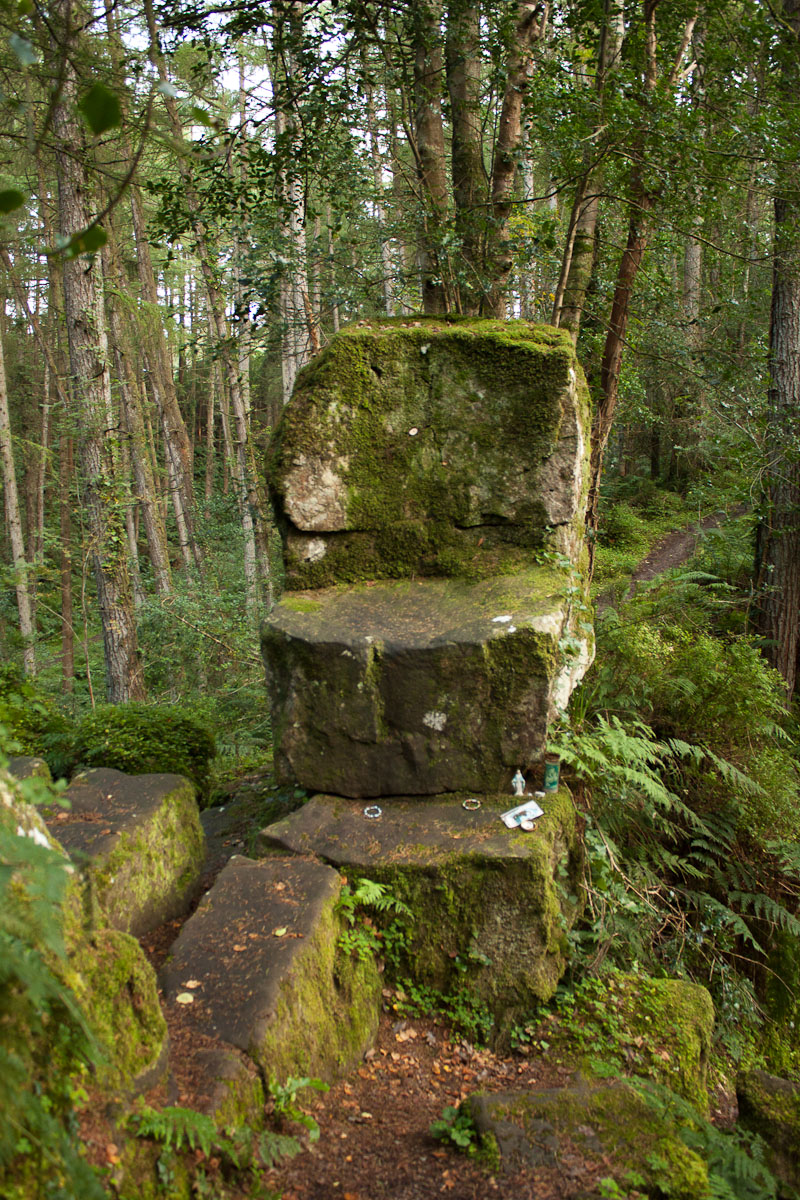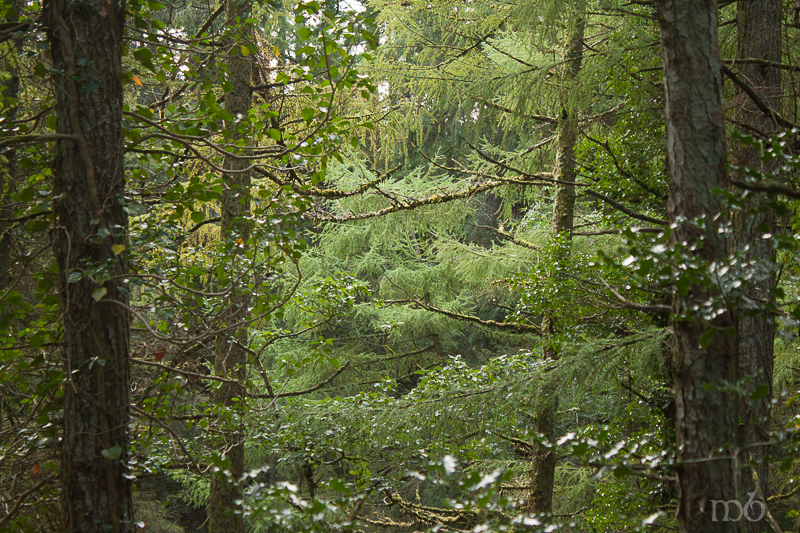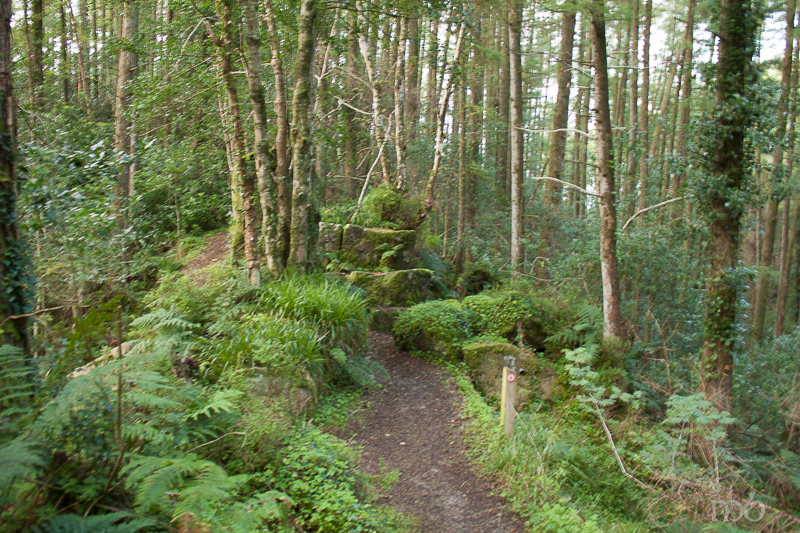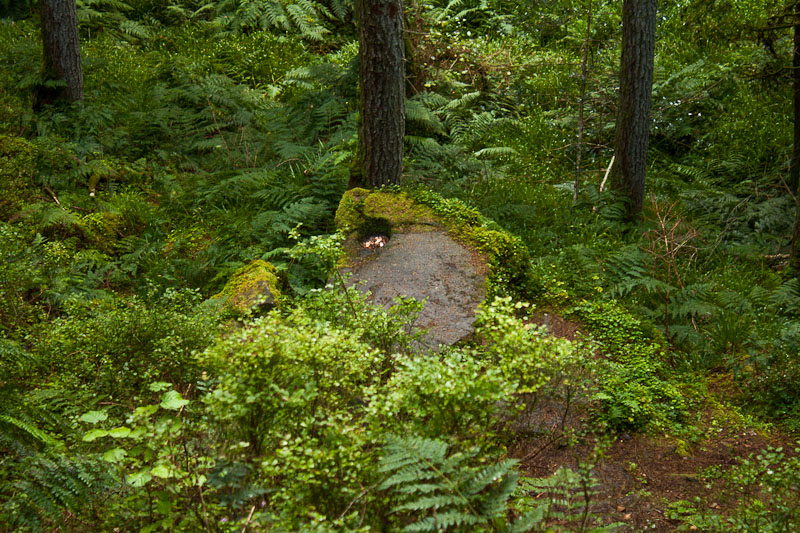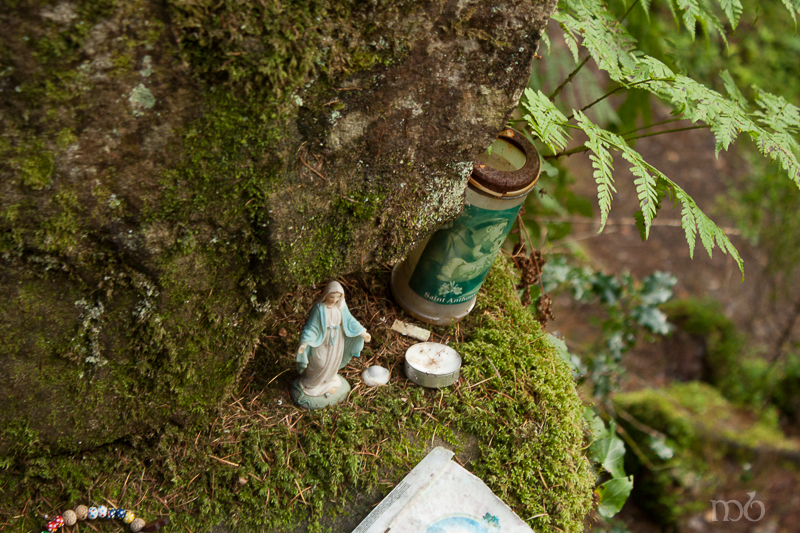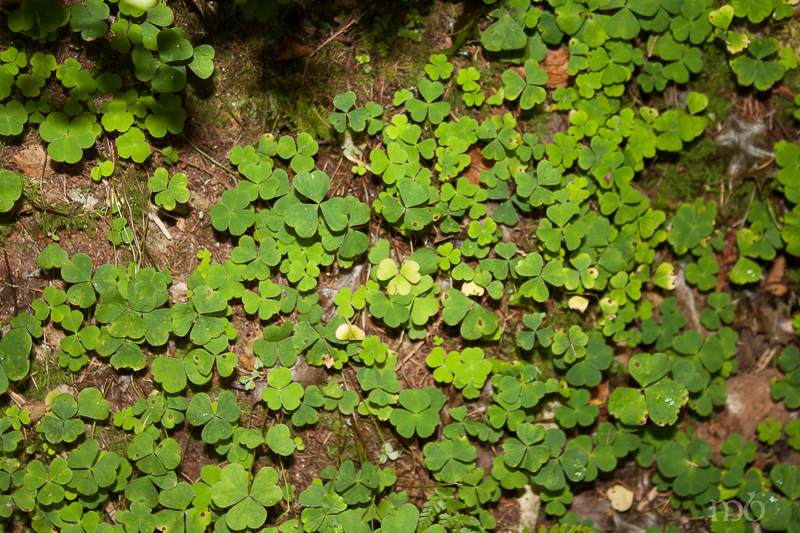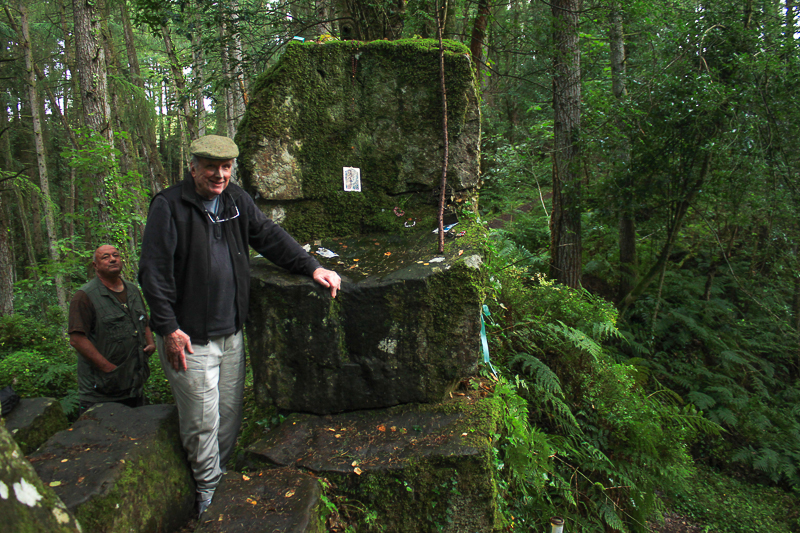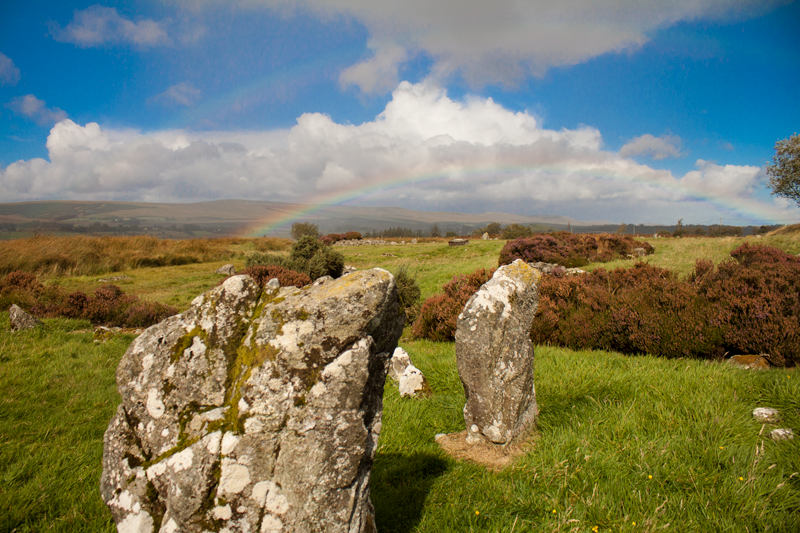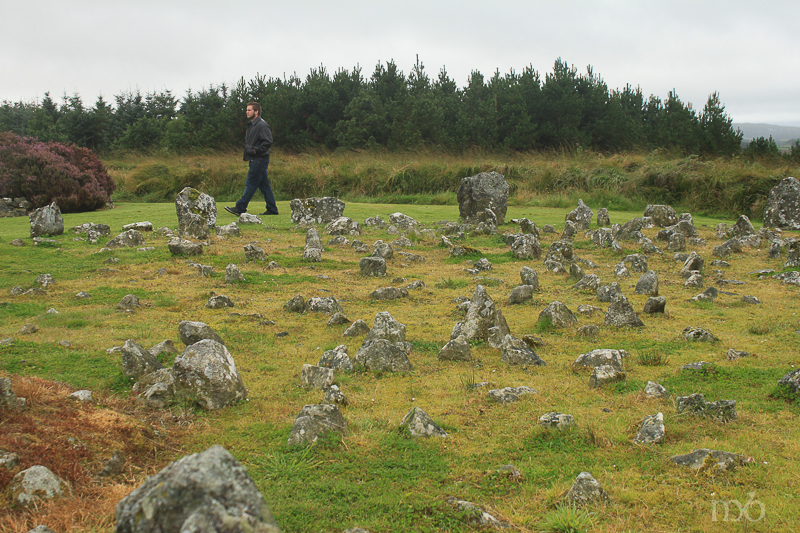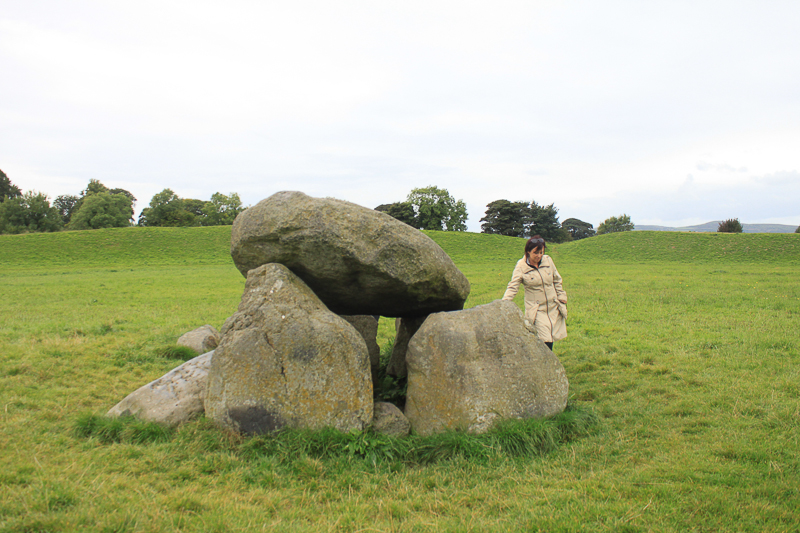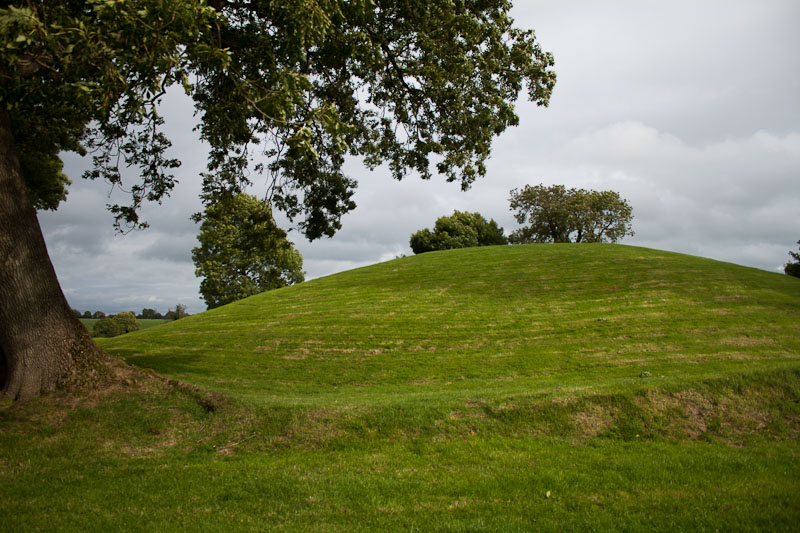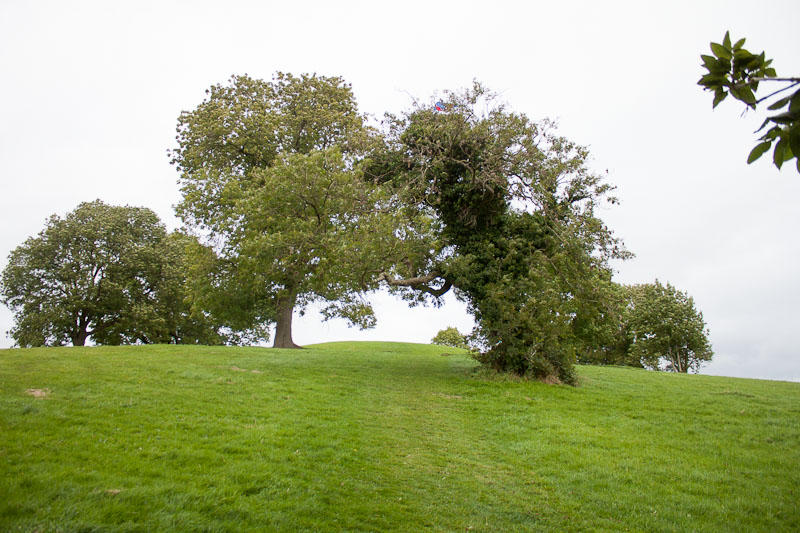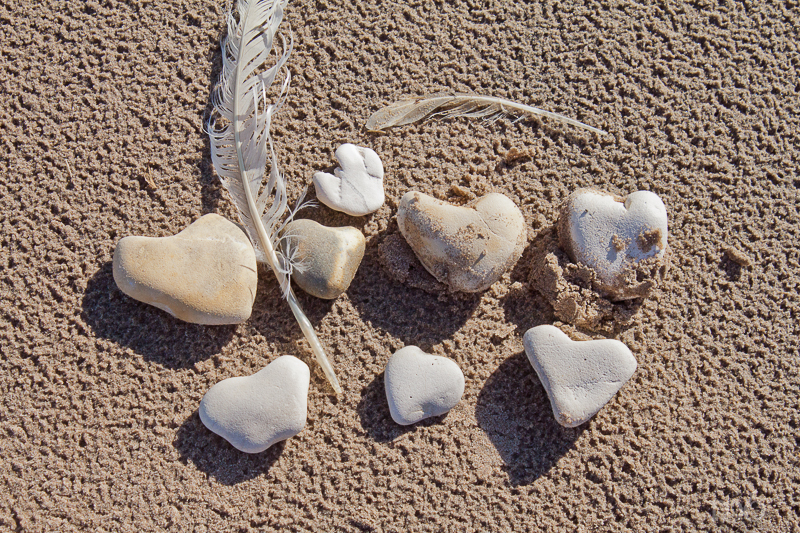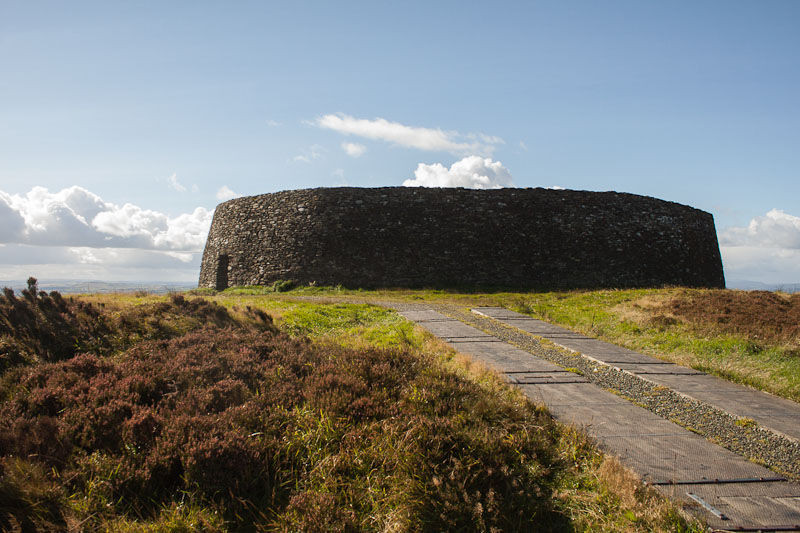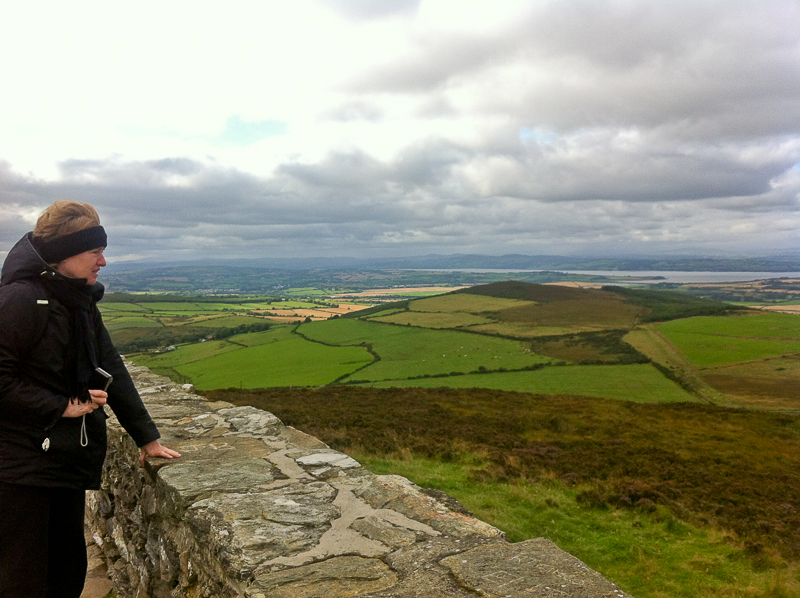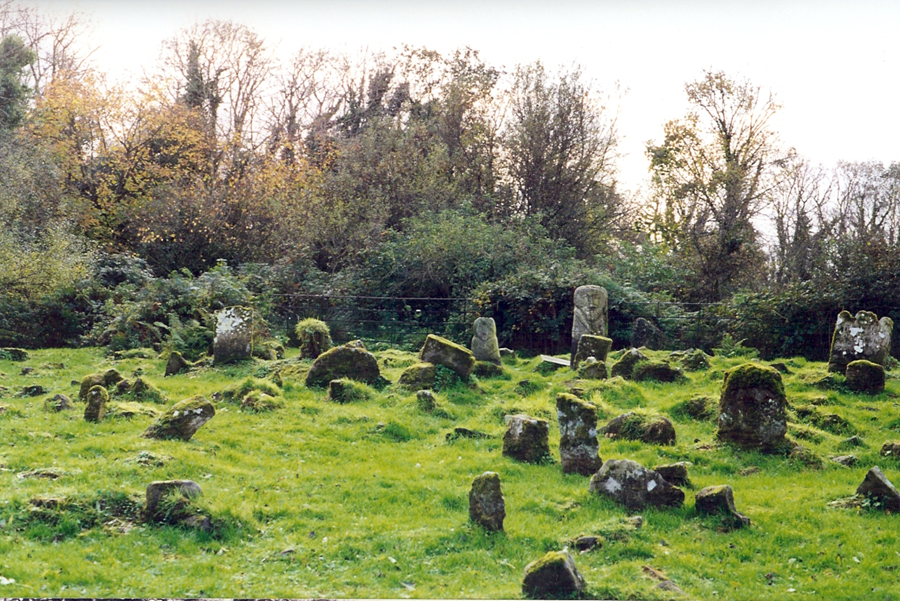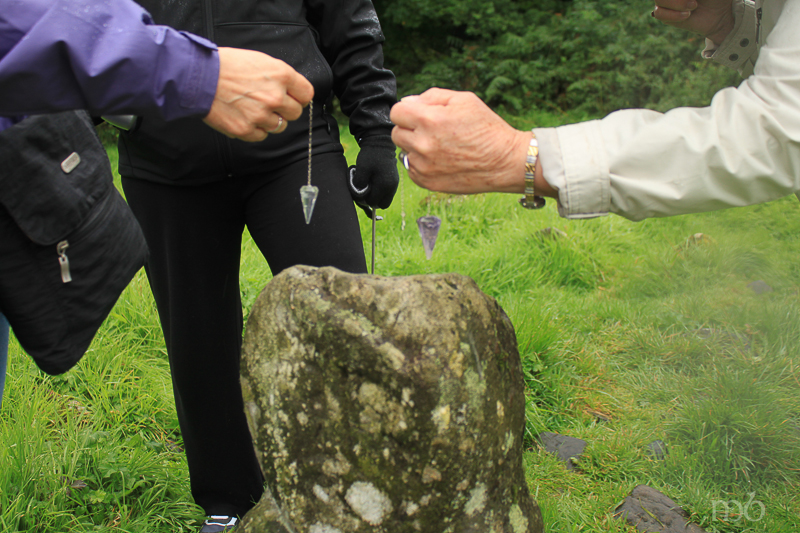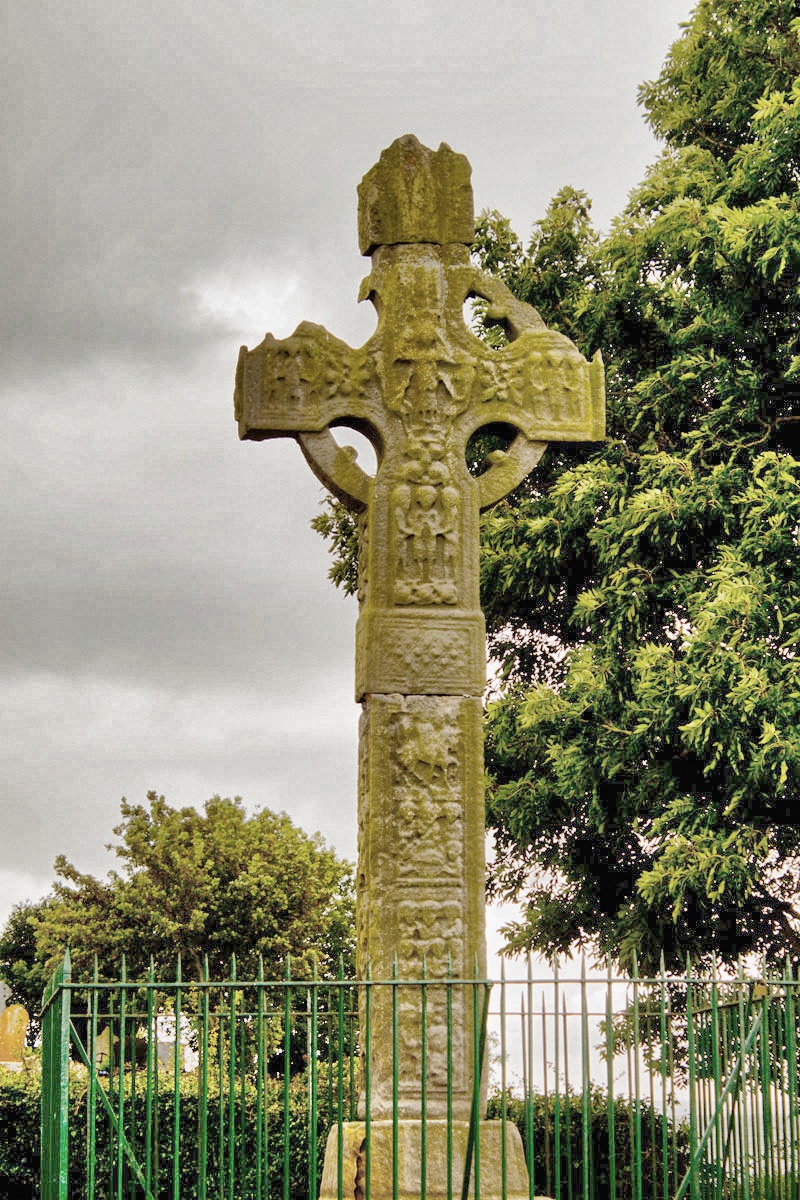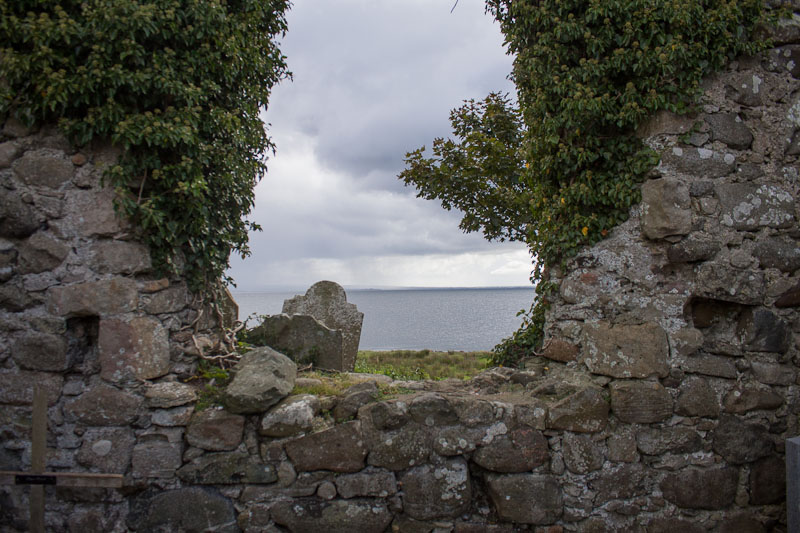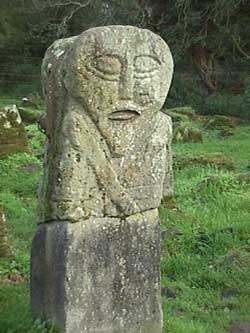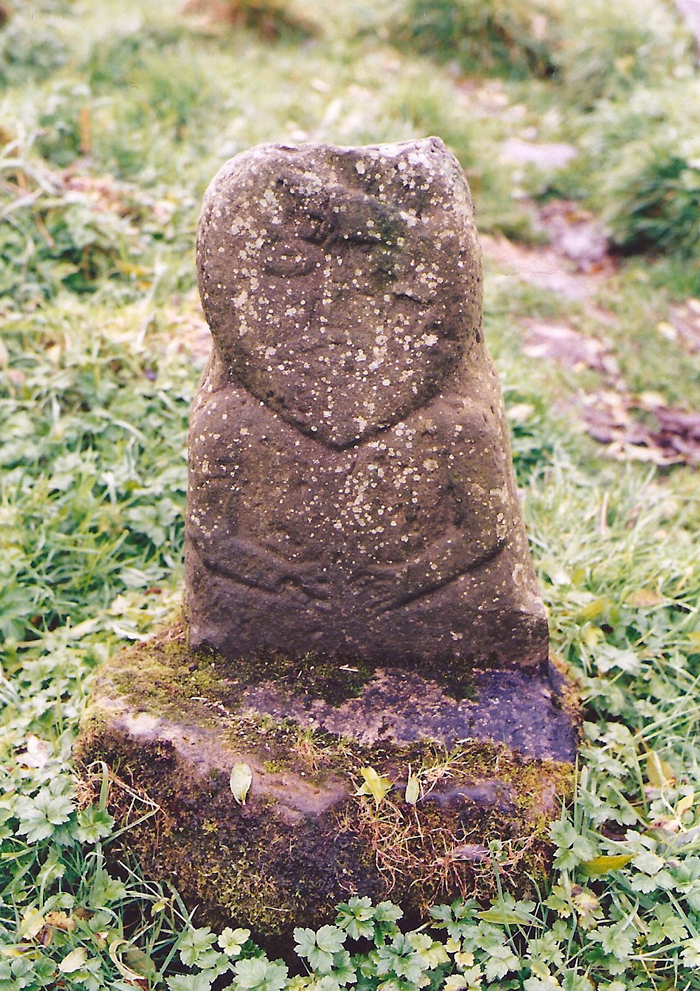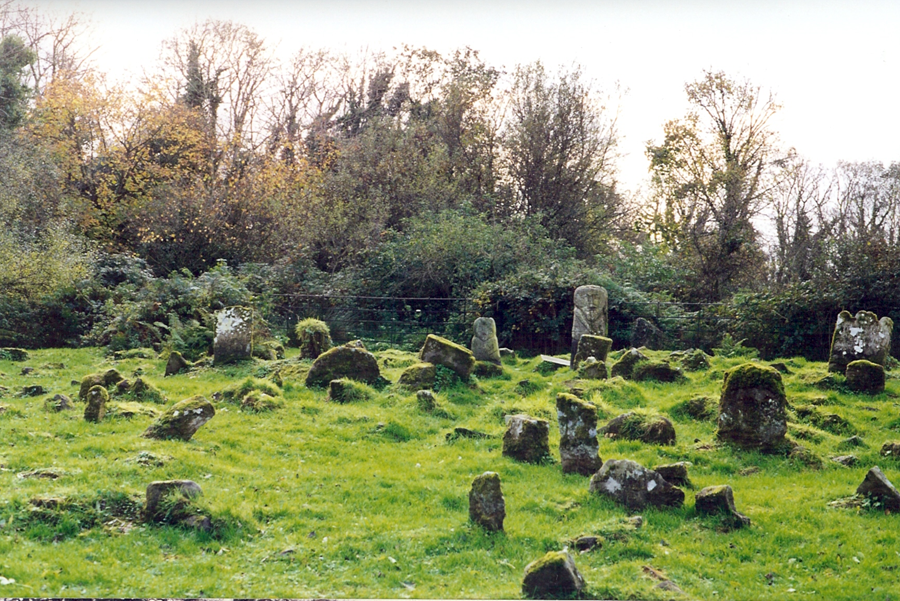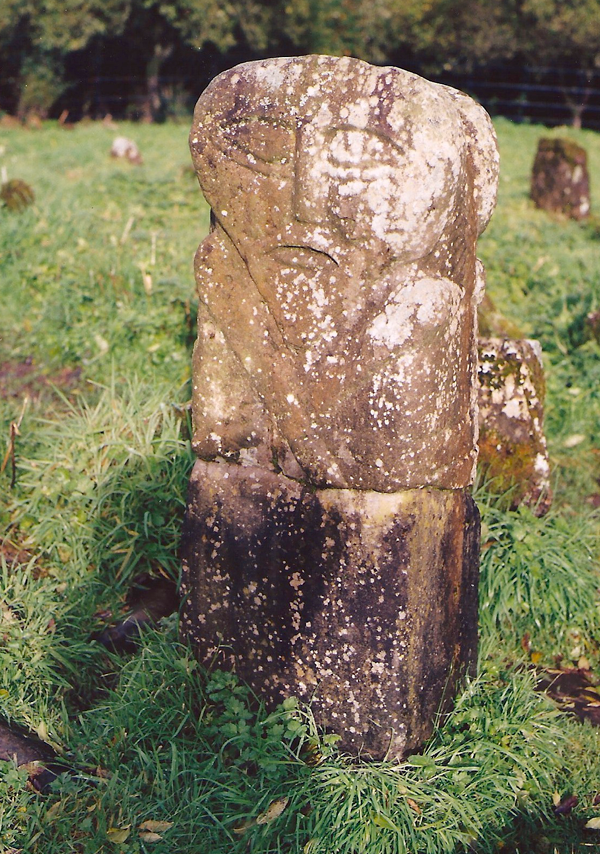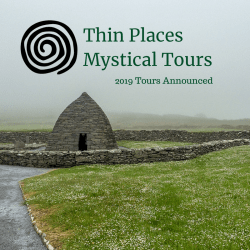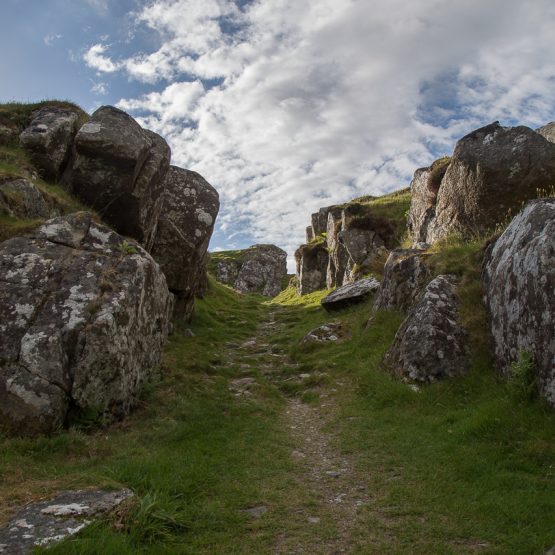Faces in the Rock – Glenariff Woodland
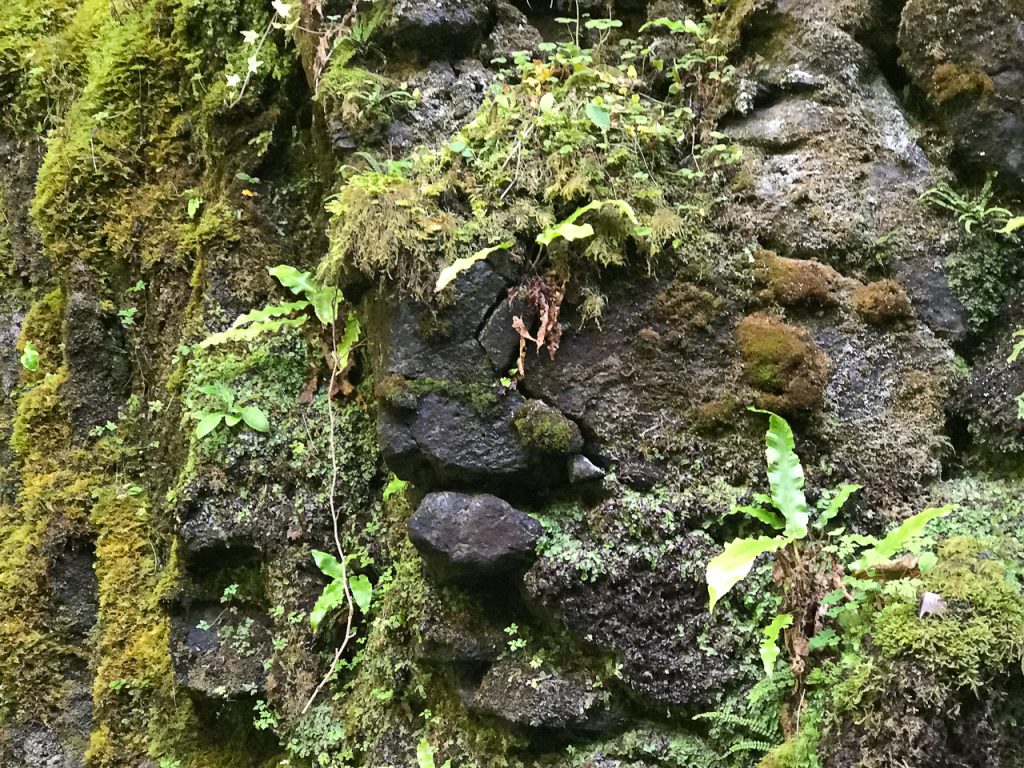 Forests and Woodlands tend to scare us. If they don’t evoke fear they at least elevate our senses. The edge is defined. We feel it as soon as we cross from the open world into a woodland. The energy shifts – changes.
Forests and Woodlands tend to scare us. If they don’t evoke fear they at least elevate our senses. The edge is defined. We feel it as soon as we cross from the open world into a woodland. The energy shifts – changes.
My friend, Wendy Mews leads tours to sacred sites in Brittany. Wendy led me through a forest near her home in Huelgoat and talked about “walking meditation.” She said that she will tell her tour guests to walk in the forest as a group – but in total silence. And she instructs her guests to notice details in that silence, to be mindful of what the forest tells them. “What do you hear in your heart? What do you feel? What does the forest tell you?”
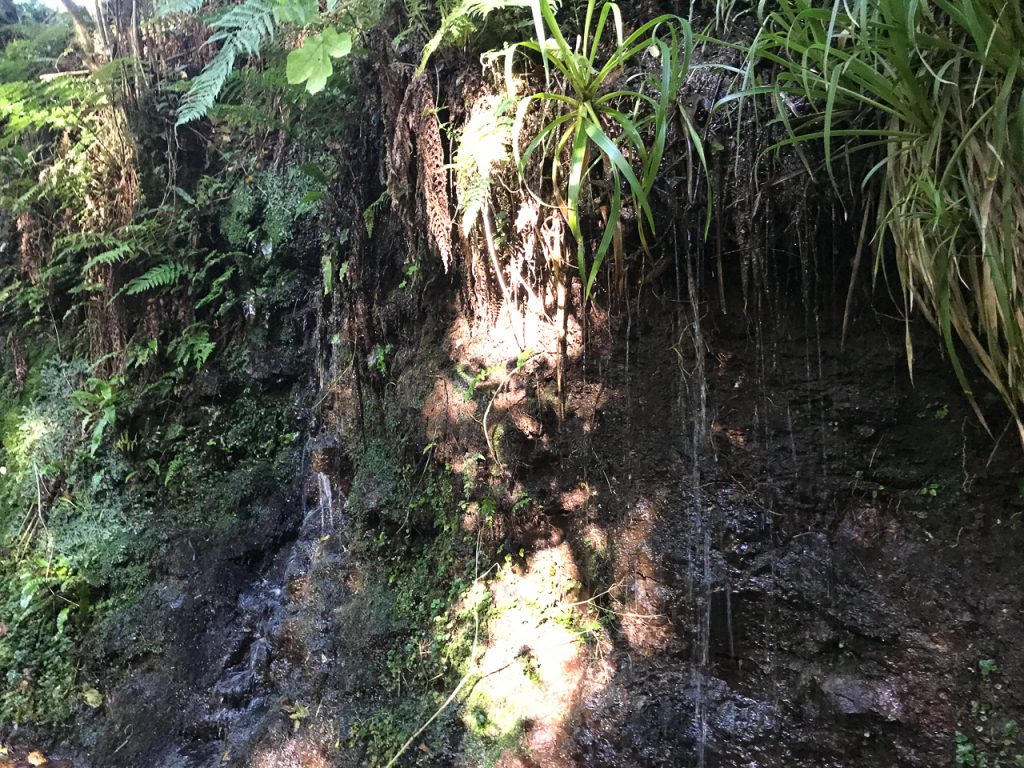
It’s funny how a chance conversation can you change one’s life. Since that conversation with Wendy, I’ve been unable to walk into a forest and not be mindful of what its telling me. I try to walk in silence…to notice details… to see what reveals itself.
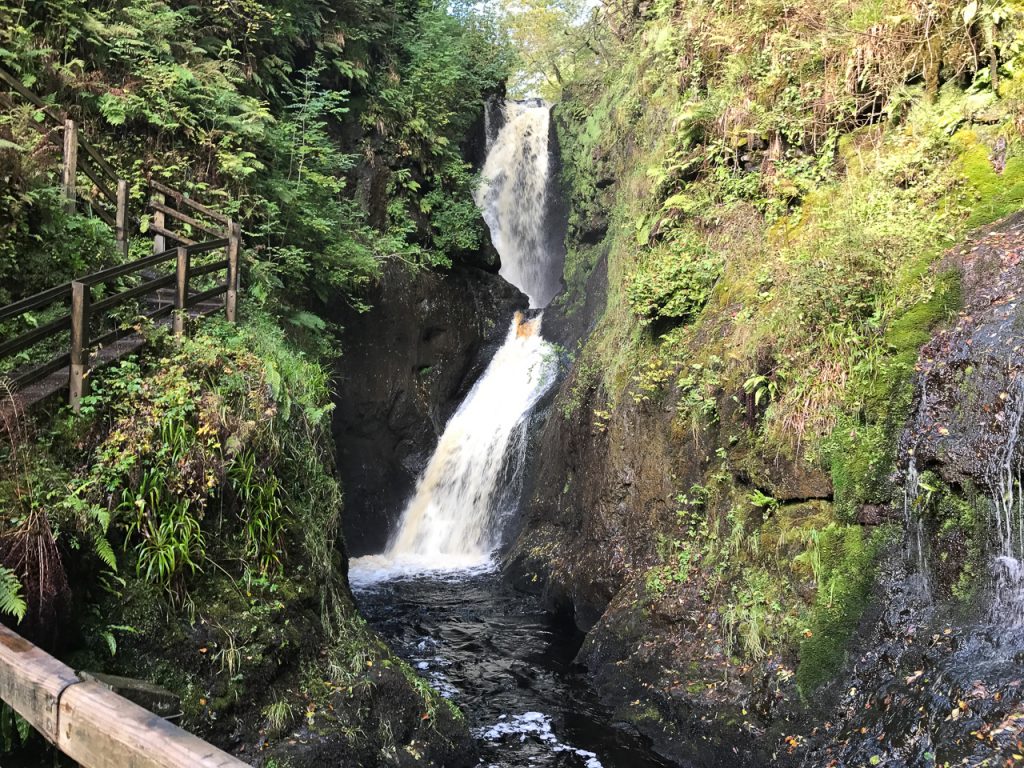
The Glenariff Woodland
In the Glenariff Woodland, there is a defined path that easy to walk. It winds into a gorge with rushing water, waterfalls, mist coming off of the rocks, all the mystical plants – ferns, ivy, holly, and a rare woodland plant known as “St. Patrick’s Cabbage.” The path is lined with oak, ash, willow and hazel trees.
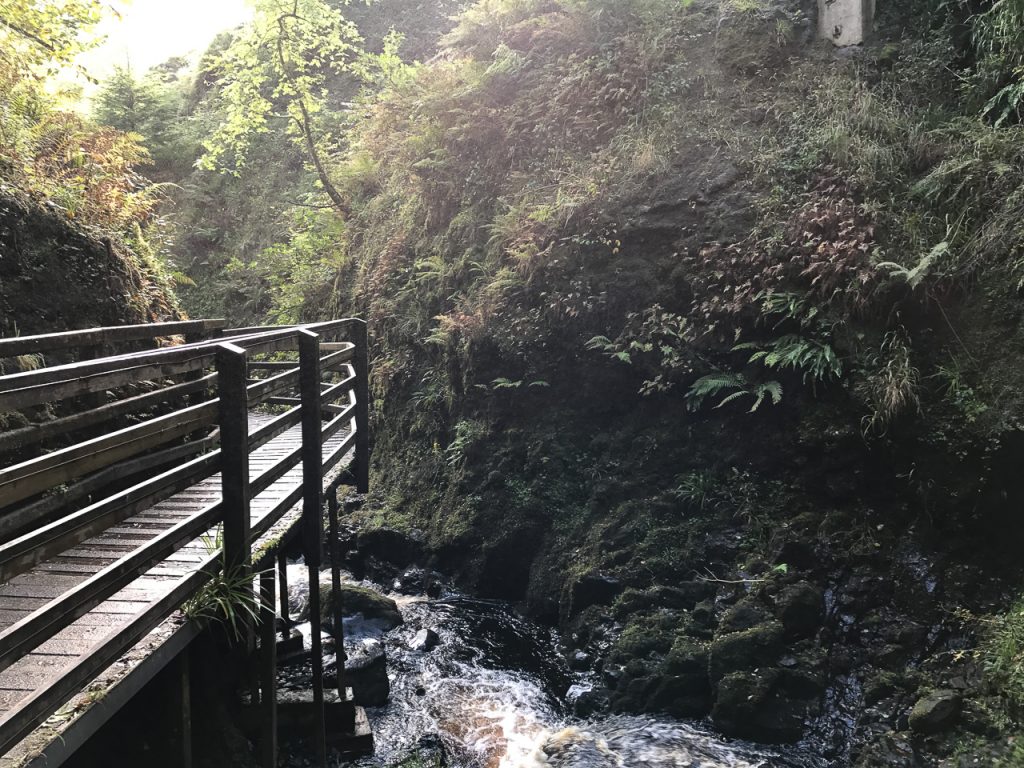
This forest was a stop on our Discover the North tour. I led my tour guests into this woodland and let them roam.
I stayed behind and then walked in silence…waiting for the woodland to speak to me.
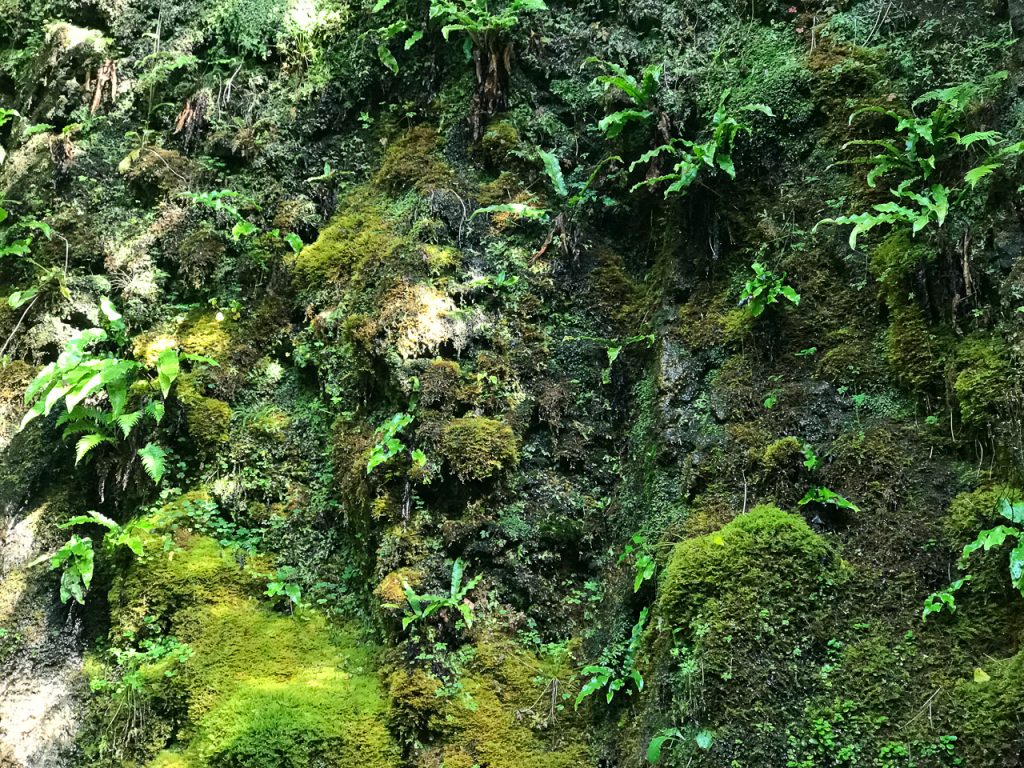
Faces in the Rock
There was a holy well along the path that had a few clooties tied to branches in the rock face.
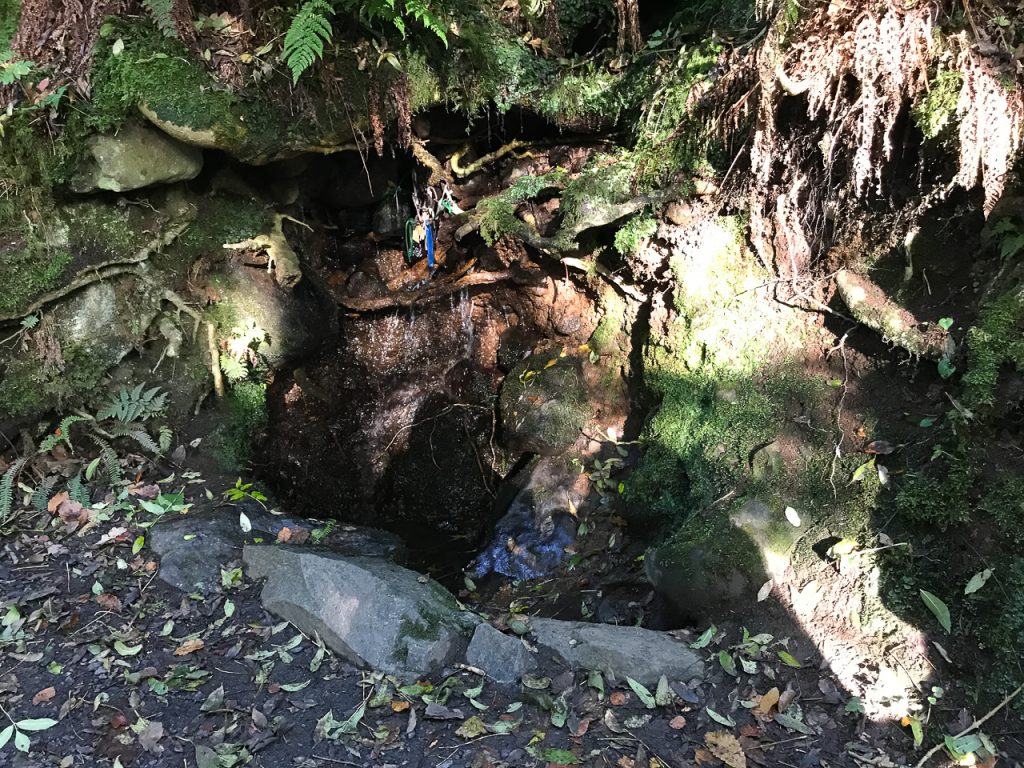 As my guests passed by me, they seemed to walk in silence too, though I hadn’t instructed them or encouraged them to do so. They were all so happy in that woodland. I stopped for a moment where the gorge wall rose steeply above the path – almost perpendicular to where we stood. In that time of reflection waiting for the woodland to “speak to me” I started to see faces – hidden in the rocks, moss, ferns and the watery surface of the gorge – – many faces. Faces made from the natural elements.
As my guests passed by me, they seemed to walk in silence too, though I hadn’t instructed them or encouraged them to do so. They were all so happy in that woodland. I stopped for a moment where the gorge wall rose steeply above the path – almost perpendicular to where we stood. In that time of reflection waiting for the woodland to “speak to me” I started to see faces – hidden in the rocks, moss, ferns and the watery surface of the gorge – – many faces. Faces made from the natural elements.
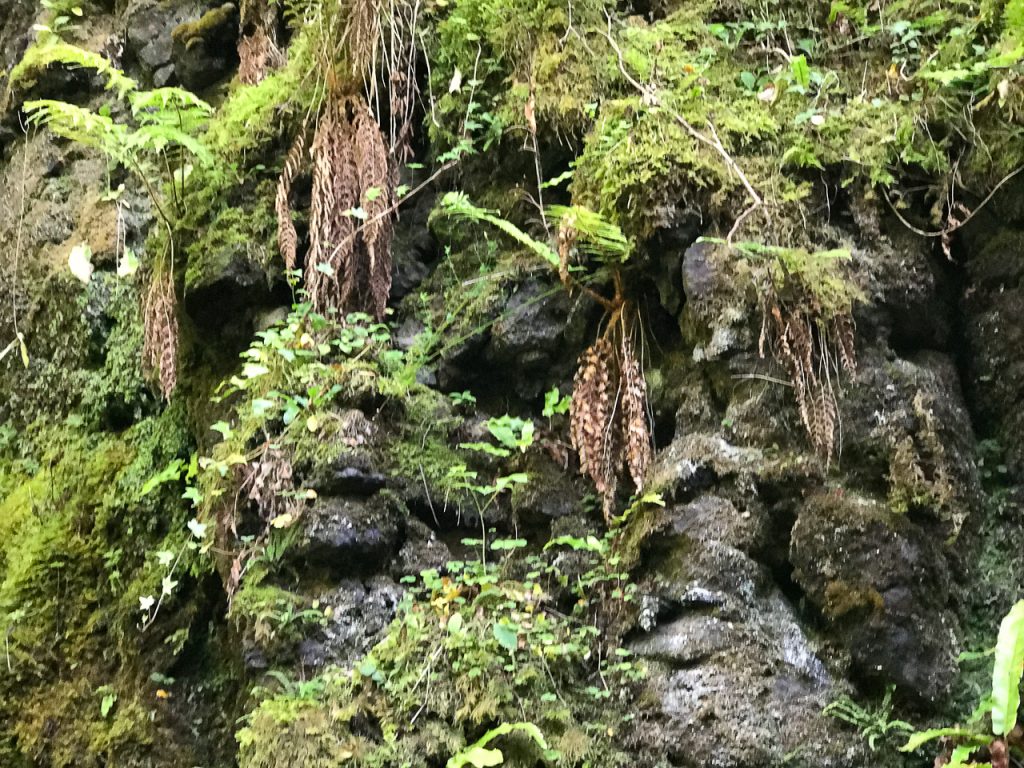 I pointed this out to my guests when they passed, and they saw them, but weren’t moved by them – not like I was anyway.
I pointed this out to my guests when they passed, and they saw them, but weren’t moved by them – not like I was anyway.
The Glenariff Waterfall Nature Reserve
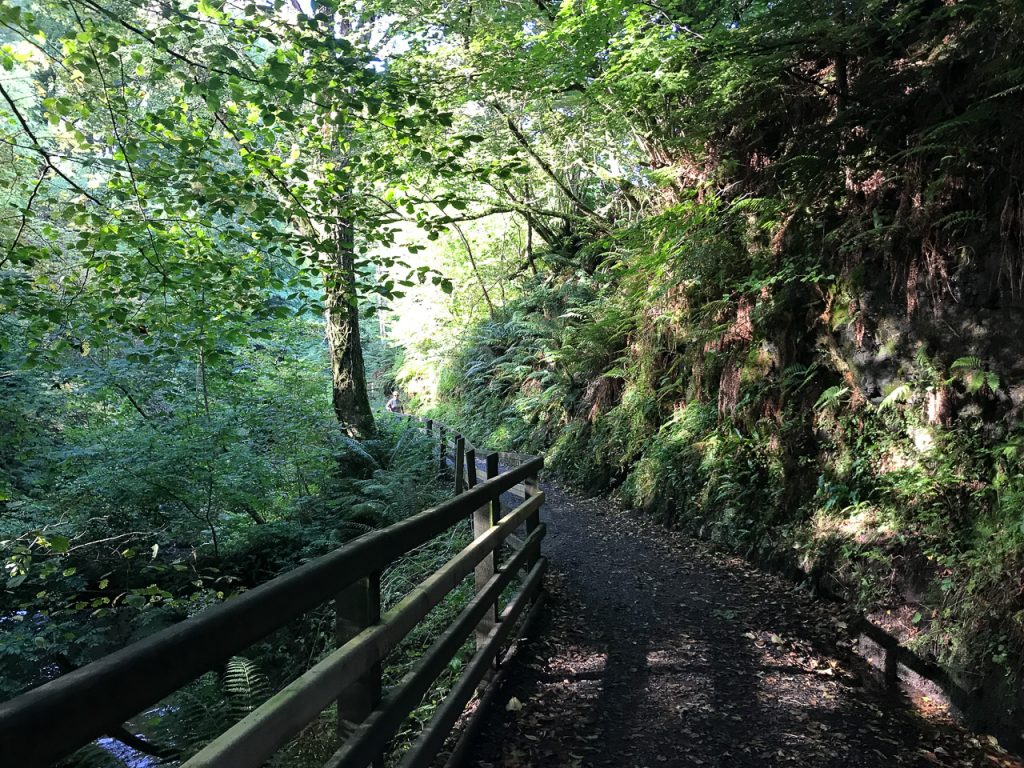
Glenariff Waterfall Nature Reserve is in the Glens of Antrim. Glenariff the largest of the nine Glens and many think it’s the most scenic. This entrance to this woodland path is located behind Large Lodge, a seasonal restaurant that has a wonderful ambiance and good food. You can park in the Lodge’s lot, have a bite to eat and then amble along the gorge path. The complete walk is about 1.5 miles and has steps and gets steep at times. But those who can’t negotiate the stairs can still enjoy the beginning of the trail.

The waterfalls and woodland are magical. Maybe you’ll see the faces.
The Glenariff Woodland Walk is on the Discover the North tour of Ireland.
White Park Bay on the Antrim Coast – Where the Sand Sings
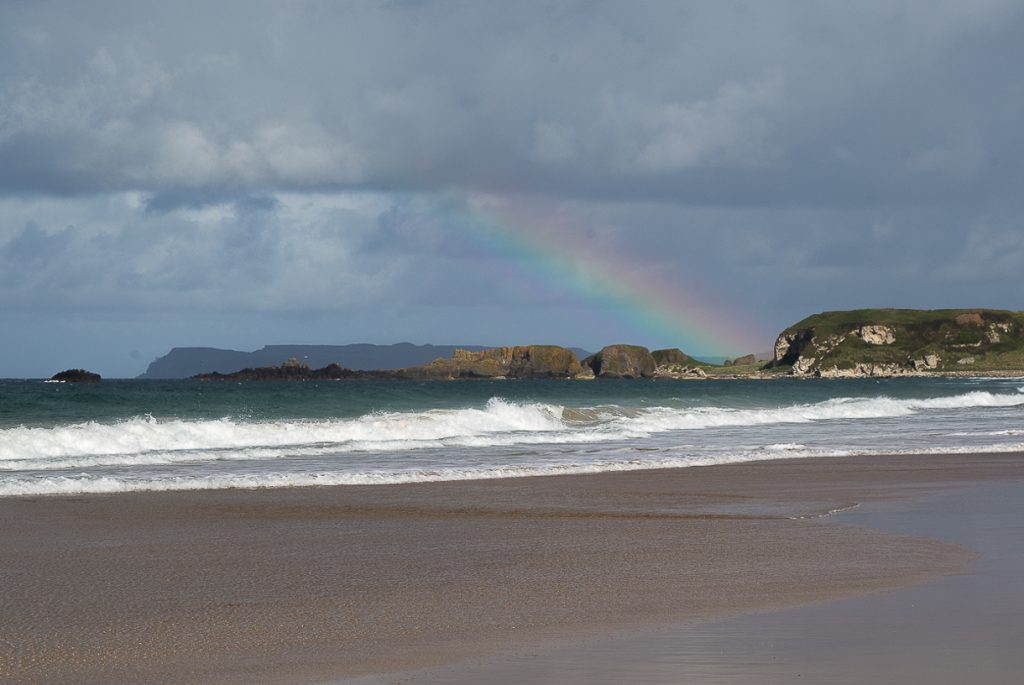
Whitepark Bay – County Antrim.
White Park Bay sits on the Antrim Coast between Ballintoy and the Giant’s Causeway. It’s a two-mile long, crescent shaped beach with a series of dunes that run up to a chalk cliff border. The landscape is an ancient one, and many believe that it was here that the first settlers entered Ireland. Artifacts found in the region date back to 8000, B.C.
Archaeologists believe that White Park Bay was a manufacturing hub for axes and arrow heads due to the availability of flint nodules in the cliff-face. The dunes just below the cliffs have been declared an Area of Scientific Interest due to the abundance of the fossils found in them and around them. The dunes are brush covered but in the brush are rare plants, grasses and a variety of orchids.
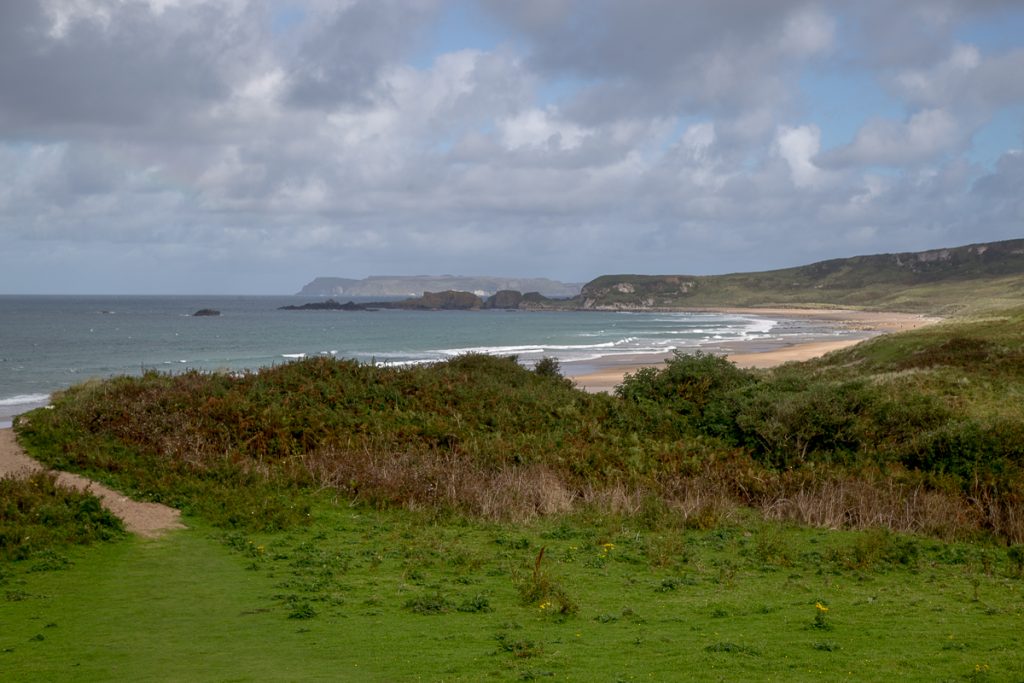
Whitepark Bay beach
The views are stunning, and if you’re lucky enough to get there on a clear day, it’s possible to see the coast of Scotland across the Irish Sea.
An Ancient Sacred Landscape
Buried under the brush in the cliff-face is an old passage tomb probably dating back to 3000 B.C. If you walk to the center of the crescent and stand with your back to the water’s edge looking back to the cliffs, you can there are 3 more passage tombs in the landscape. They are on higher ground across the road rising above the chalk cliffs. All these tombs face the sea. It makes one wonder if this area isn’t part of larger sacred landscape.
Sacred landscapes are charged with earth energies. White Park Bay has a rare energy and elements of enchantment. A man-made stairway makes getting down the cliff-face from the car park easy. The stairs empty onto a path that winds past the ruins of an old school and out to the wide beach.
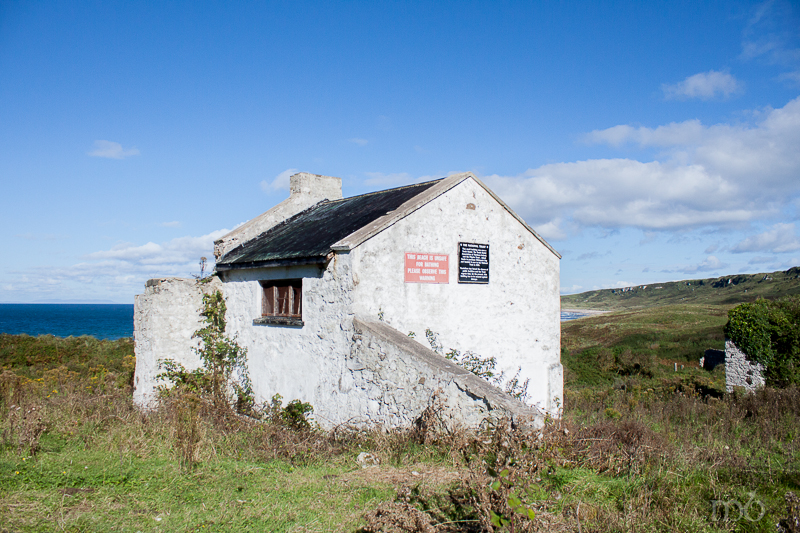
Old School – Whitepark Bay
The Singing Sand
Footsteps on the sand create a kind of “singing” or humming sound. This singing sand phenomenon that occurs on some beaches in the UK and in only 30 places around the world. Sometimes it’s a squashing sound that is made as a result of feet hitting the sand as a person walks across. More pronounced “singing” occurs as a vibration – a sort of humming that washes across the entire landscape.
The day I visited White Park Bay, I specifically listened for the singing and didn’t hear it. Finally I picked up on the squashing sound when I walked across the sand, but that was near the dunes where the sand was more loose and dry. But when we came out into the open – out in front of the dunes, I heard it faintly at first … the buzzing sound … a hum. Then it faded. But it was a remarkable thing to hear.
This video on www.BoreMe.com demonstrates both kinds of singing sand and offers some explanations about why this phenomenon occurs.
Faces in the Stones
The stones on the beach at White Park Bay are either smooth like river rock or sharply cut like fossils. The stone colors are mostly white accented by shades of grey, but they’re incredibly bright. I’ve seen faces and shapes in random stones before, but it’s usually one or two after I’ve combed through stones for about an hour. And White Park Bay they seemed to pop out of the landscape everywhere. I found myself seeing faces on every other stone. This is a psychological phenomenon – seeing faces or shapes in meaningless randomness. Carl Sagan suggested that humans are hard-wired to look for the human face. Psychics and Spiritualists will say this is part of being Clairvoyant – that the shapes or face images are derived from both the brain and a universal source.
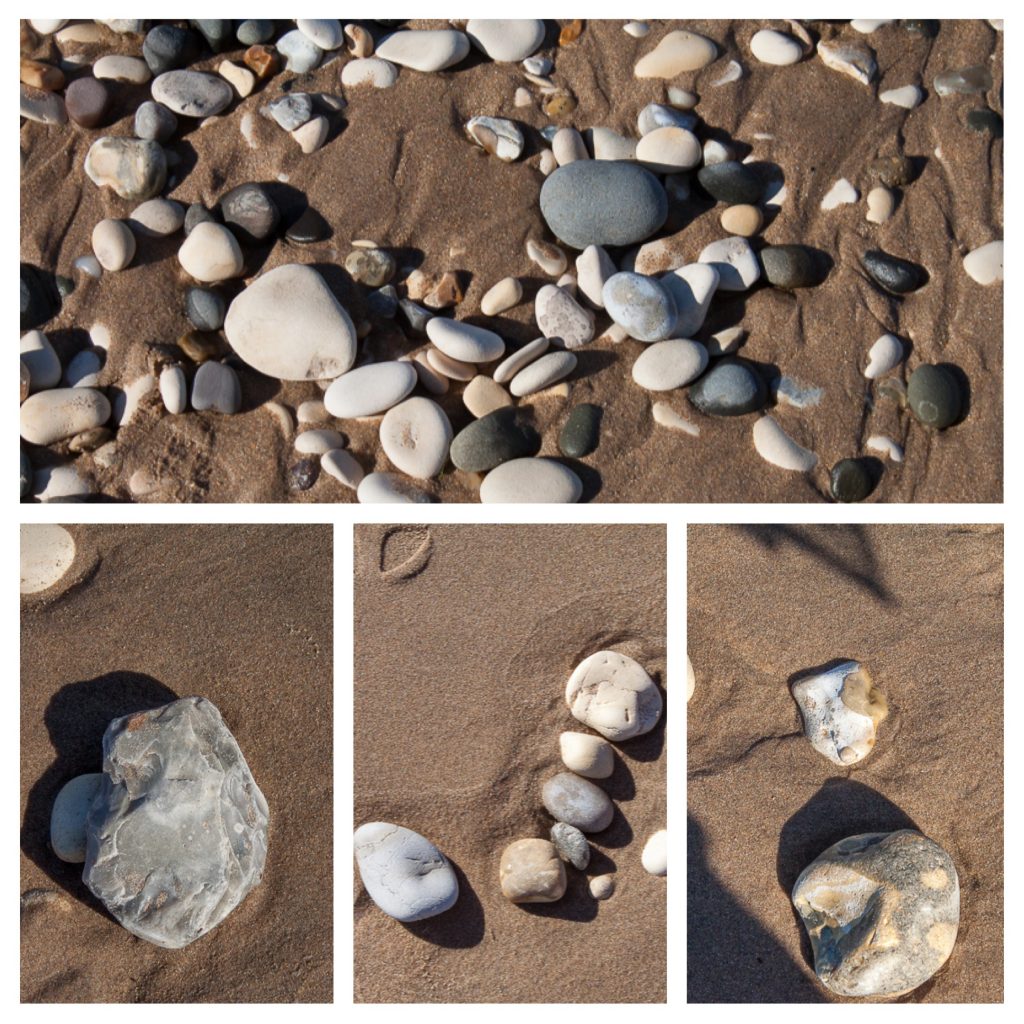
Whatever it is – a psychological phenomenon or a psychic capability, it seems to happen in exponential proportions at White Park Bay.
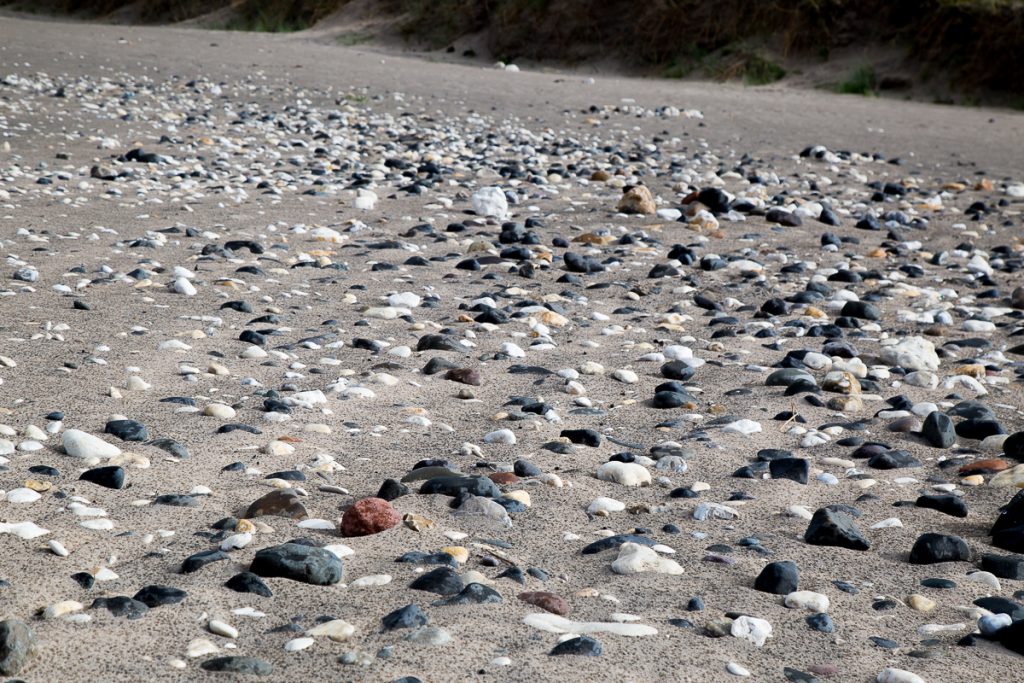
I visited White Park Bay with my friend Maura Brooks who lives in County Tyrone. I was telling Maura about a tradition I started with my twin granddaughters since I travel so much. I always bring each of them a heart-shaped stones from wherever I’ve gone. The easiest place to find them is on a beach where there is an abundance of stone.
I’m usually pretty lucky and after about a half hour to an hour I’ll be able to find two that resemble a heart shape. If I’m with my husband, he’ll help and we both look. So I asked Maura to help me look at White Park. Within minutes after beginning the search I found a perfectly shaped heart stone. Then another. Then a third. It was crazy. The hearts were all but jumping out of the sand. Maura found several as well. Within about 10 minutes we found eight heart-shaped stones and two feathers.
In the Celtic tradition, feathers a symbolic of knowledge from the celestial realm. Egyptians, Europeans, the Nordic people and First Nation people in the Americas all shared a similar interpretation of feather symbolism and used feathers as ornaments in ritual dress and practice. Basically, feathers symbolize the connection between the heavenly world and the physical world.
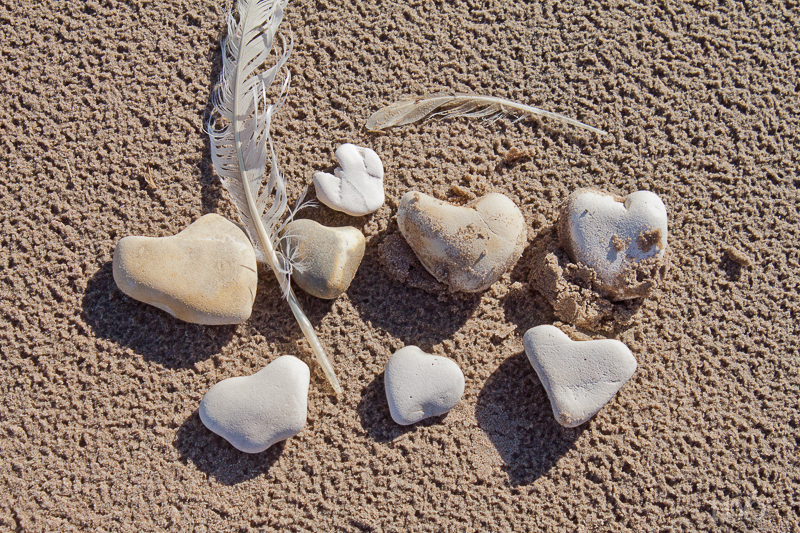
Hearts at White Park Bay
First the singing sand, then the stones with faces, and now the hearts finding us. This was a magical place.
Touching the Other Side at White Park Bay
My friend Maura is a psychic and a medium. When we first walked out onto the beach there was a large stone with a child’s shoe on it. I assumed someone found it and set it on the stone in case a parent came back looking for a lost shoe.
When we left White Park Bay and climbed the stairs that led back to the car park, we noticed a bench that visitors could sit on and look out across the beach and sea. It was almost at the very top of the cliff. The panoramic views from there were awesome. It was an amazingly peaceful setting.
I sat down on the bench, then we both noticed that just in front of the bench were wilted a cluster of wilted lilies.
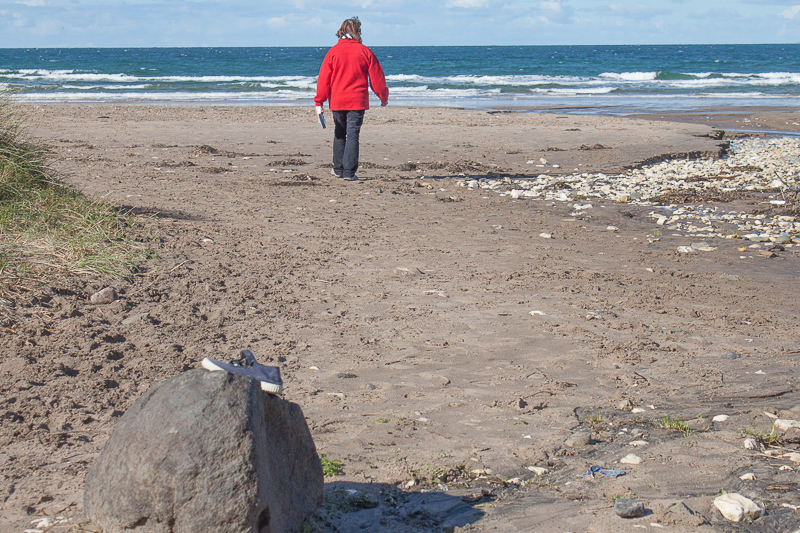
Then Maura heard the words “Good-bye, little one.” She sensed that the shoe belonged to a child who died and the parents placed the shoe on the stone and then released the child’s ashes over the cliff in front of this bench – and then left the lilies as a symbol of remembrance.
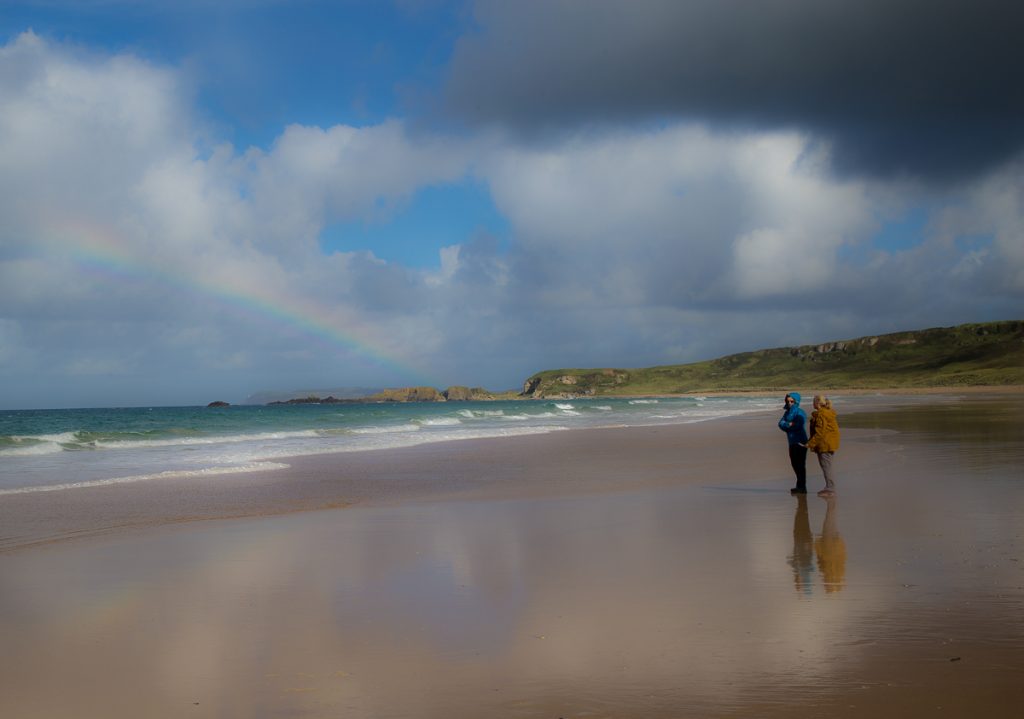
Walking the beach in September – White Park Bay
White Park Bay is a secluded beach in a pristine setting that is worth seeing if just for the stunning beauty of the Antrim Coast. But if your senses are keen and you open yourself to the eternal world, White Park Bay is one of those rare, thin places where it’s possible to walk in both worlds simultaneously.
White Park Bay is on the Discover the North Ireland Tour .
Discover the North Tour 2016 Begins with the Blessing of St. Brigid

Statue of St. Brigid at Tobar Bride – St. Brigid’s Holy Well in Kildare
The 2016 Discover the North tour started in Dublin today as our 18 guests arrived at Dublin Airport from many parts of United States and Canada. One of our favorite places to take guests on the first day is to Solas Bhride – a center in Kildare run by Brigidine sisters who provide a warm welcome and the blessing of St. Brigid.
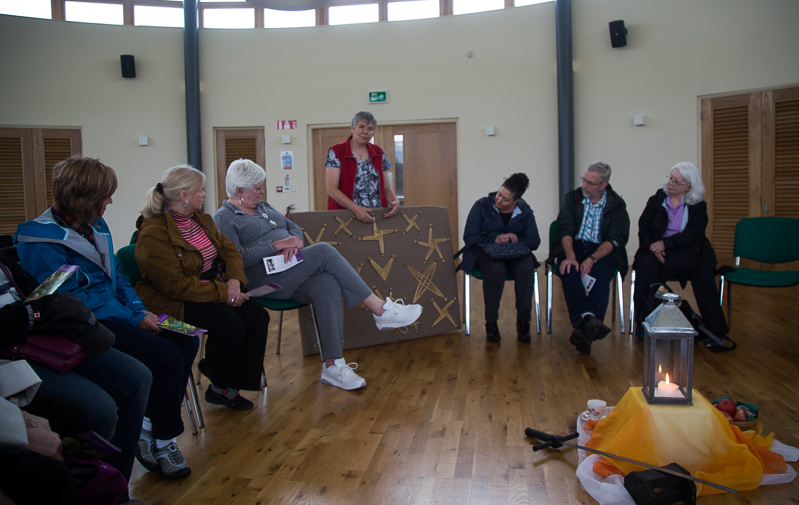
Sr. Phil talks about the tradition of the St. Brigid’s Cross at Solas Bhride
Our guests gathered for the first time as a group today at 1pm for a short meeting. Then we boarded our bus in the rain. It was a damp, dreary day. But the dismal atmosphere lifted when Sister Phil and Sister Mary met at the door of this Christian spirituality center that welcomes people of all faiths and of no faith within the context of the Solas Bhride vision to unfold the legacy of St. Brigid and its relevance for our time.

Sr. Phil weaves a St. Brigid’s Cross – Solas Bhride
I can’t think of a better place in Ireland for bringing people together for the first time. After a brief tour of the center, Sister Phil arranged the group in a circle and wove a cross of St. Brigid. With each rush she wove into the cross, she asked the group what they would like to “weave” into their journey this week. As members of this newly formed tour group called out things like friendship, forgiveness, humor, love, respect, St. Phil added a rush to the cross – each rush representing a hope for the journey. At the end she presented me with the cross, and we’ll keep it on the bus in plain sight as a reminder of the blessings received at Solas Bhride…. as we move through these coming days together.

Sr Phil presents the cross to me (Mindie Burgoyne)
The traditional blessing of the St. Brigid’s Cross to be hung in the home is:
“May the blessing of God and the Trinity be on this cross, and on the home where it hangs and on everyone who looks at it”
So we’ll shift that bit and substitute the word “bus” for home and keep at a point of focus on our journey together.
After Solas Bhride (means the light of Brigid), we went around the corner to “Tobar Bride” – St. Brigid’s holy well – a site of local pilgrimage where the water from a holy well runs out to little spring that flows around a small island with a bronze statue of St. Brigid holding a crozier and a flame. (see image above) The peace is palpable in this place.

Clooties on the tree at St. Brigid’s Holy Well – Kildare
There’s a clootie tree by the well (sometimes called fairy tree or rag tree) where pilgrims leave tokens of devotion – something that represents an intention left behind. Today was an interesting array of clooties.
I still believe that every person on our thin places tour was called to that particular tour for a reason. We all have been called to be a collective part of the “whole” that will make up this tour. The first day is always a prayerful time for me. I pray everyone is blessed, inspired, enlightened and celebrated.

Part of our Discover the North 2016 tour group at the welcome dinner in Dublin
So Dan and I welcome you all – Julie, Suzanne, Karen, Richard, Cheryl, Don, Tricia, Anita, Marianne, Kathy, Moyra, Karen, Eleanor, Sally, Jen, Ann, Ruth and Danny.
Here’s to Ireland, new friends, new discoveries and thin places.
Images in the Landscape Tour
The Images in the Landscape tour of thin places in the West of Ireland starts in two days, but the complete journey includes the anticipation that comes before travel when we imagine the journey.
So according to that understanding I am already traveling because I’m full of anticipation.
In 2012, I guided a small group of guests on a 10-day thin places tour in the West of Ireland. One of our stops was Coole Park, the home of Lady Augusta Gregory. She and William Butler Yeats and several others were behind much of the Irish Literary Revival in the early twentieth century. Her manor house is gone now, but the grounds, which include formal gardens, a lake and seven woodlands still appear much as they did when she was there overseeing them.
In 1931 Lady Gregory wrote about the grounds around her home:
“These woods have been well loved, well tended by some who came before me, and my affection has been no less than theirs. The generations of trees have been my care, my comforters. Their companionship has often brought me peace.”
As my tour group entered Coole Park, I overheard a park guide addressing a group of tourists. He said, “You have all now just become an image in an ancient landscape.” I thought about the phrase as I continued to walk. Later, that same phrase became a powerful meditation mantra for me.
How many ancient landscapes do we walk through in this life? And how many times are we are reflective enough to connect with them … to become a part of them … to sense the past that swirls around us?
Claiming that Space Between the Inner and Outer Ancient Landscapes
Since that walk in Coole Park three years ago, I’ve led four group tours to Ireland’s thin places, and today I am getting ready to do another, and we’ll be cycling back to Coole Park. The name for this tour is Images in the Landscape. So now …. a phrase dropped by a tour guide in one little slip of a moment will set the tone for the traveling experience of eighteen people.
We will be visiting Coole Park and its ancient landscape that is reminiscent of when Ireland was covered with hardwoods and deep forests, but we’ll also visit the Burren and its sweeping moonscape of rock and megaliths. We’ll journey out into Lough Corrib, a lake named for the mythical Lord of the Sea. And we’ll land on Inchagoil – Lough Corrib’s most famous island. Inchagoil takes its name from the old Irish words for “Island of the stranger” memorializing a devout man who once lived there.
We’ll wind our way through Connemara and absorb that awesome light while following one of Ireland’s most renowned archeologists, Michael Gibbons on a private tour of Connemara’s hidden landscape. Then we’ll head for Crough Patrick – the holy mountain in County Mayo, and the ruins of Murrisk Abbey at the foot of the mountain. We’ll visit Achill Island, sitting atop a bedrock of amethyst. The island radiates a healing energy while it hypnotizes visitors with its scenic coastline. We’ll walk through the Bricklieve mountains and explore a cluster of passage tombs that pre-date the pyramids of Giza. And we’ll stand on the ancient Hill of Uisneach in the mystical center of Ireland and feel the pull of the magnetic energy there.
The Journey Begins with Anticipation
The journey does not begin when we first arrive at the intended destination. It begins with the anticipation of what will come, of what we will see and learn and experience. Part of that is also worry and fear of the unknown. Travel can be unsettling for some. In looking forward to a journey, we wonder who we will meet, what challenges we’ll face, how we’ll feel once we get there and what the pleasant surprises will be. All of the forethought is part of the journey experience.
The first step in travel – we imagine the journey.
The key learning experiences – the crux of the travel story – the high impact part of the journey – the things that change us are all held in the difference between how we imagine the journey and what the journey actually is. Those differences teach us and change us. Our best memories will be embedded in those differences.
I’m Imagining This Journey
Today I imagine meeting sixteen new friends, and I expect I’ll be changed just a little by each one of them. I look forward to walking up the Hill of Uisneach and touching the Cat Stone and surveying six counties from the summit and feeling that sense of coming home. I’m excited about meeting Michael Gibbons and seeing Connemara through his eyes. I imagine all of things he’ll teach us as we walk that ancient landscape with him. I imagine Inchagoil – and its ruins … and the presence that those ruins still cling to. That will be a new site for me.
I also worry. Worrying about travel is also part of the anticipation. Will the guests get along? Will it rain too much? Will the some of the walking be too difficult for our guests – and how will we handle that? Will the hotels have everything in order? Will I remember everything?
The West of Ireland is Magical
Despite my worries, I know that the “Wow!” moments for the guests on this trip will be remarkable. They’ll never forget the Hill of Uisneach. They’ll be stunned by the raw beauty of Achill Island. They’ll learn so much from our three local guides, Tony Kirby, Michael Gibbons and Mike Croghan. And besides that… I believe no one can drive through Connemara and not be changed. It’s like walking through fairy dust. You’re journeying through several worlds there. So I rest a little knowing that the magical western landscape of Ireland in itself is a jewel that embeds itself in every traveler.
I pray for blessings on Terri, Bob, Linda, Gloria, Bev, Lea, Jim, Maril, John, Karen, Ed, Mary, BJ, Meredith, Bonnie and Renee and safe travel. I pray that John, my excellent coach driver and I will be good leaders and sensitive guides and that on September 20th when this tour is over, our imagined journey will be magnified and expanded by our actual journey and that we will all move forward together.
St. Patrick’s and St. Patrick’s – Twins, Curses and Blessings in Armagh
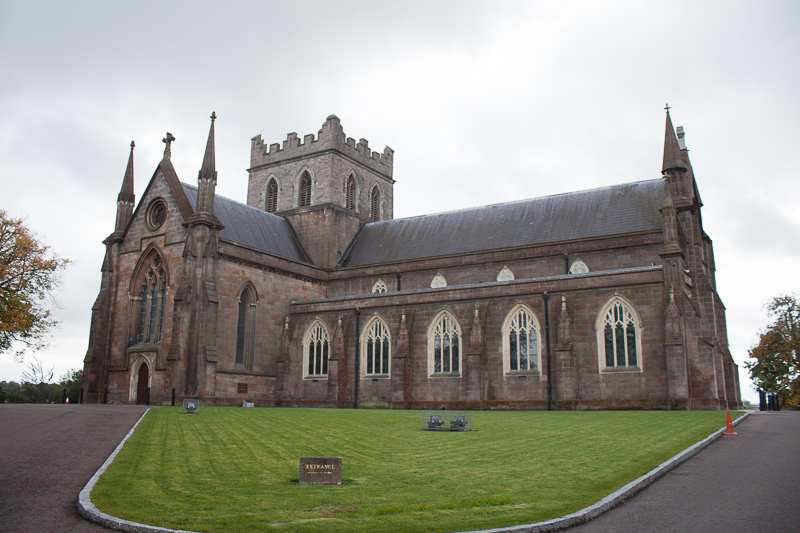 St. Patrick’s Cathedral in Armagh – Church of Ireland
St. Patrick’s Cathedral in Armagh – Church of Ireland
Coming into Armagh from the Monaghan Road one gets a dramatic view of the city skyline, especially at twilight. The view is dominated by two buildings on two hills – St. Patrick’s Cathedral and St. Patrick’s Cathedral.
Both are diocesan bishoprics, both are built on holy ground and both are tied to legends of St. Patrick. One is the Church of Ireland cathedral built on the ancient holy site where St. Patrick is believed to have built his first stone church in the 5th century. The other is a stunning Gothic-style Roman Catholic Cathedral, its cornerstone laid on St. Patrick’s Day 1840. It was completed in the early 20th century, with a serious halt to the construction during the Great Hunger. Armagh is known for being the ancient seat of the Ulster kings and the place that gave us the Knights of the Red Branch and Cuchulainn – the Hound of Ulster, a who was the Incredible Hulk of Ireland.
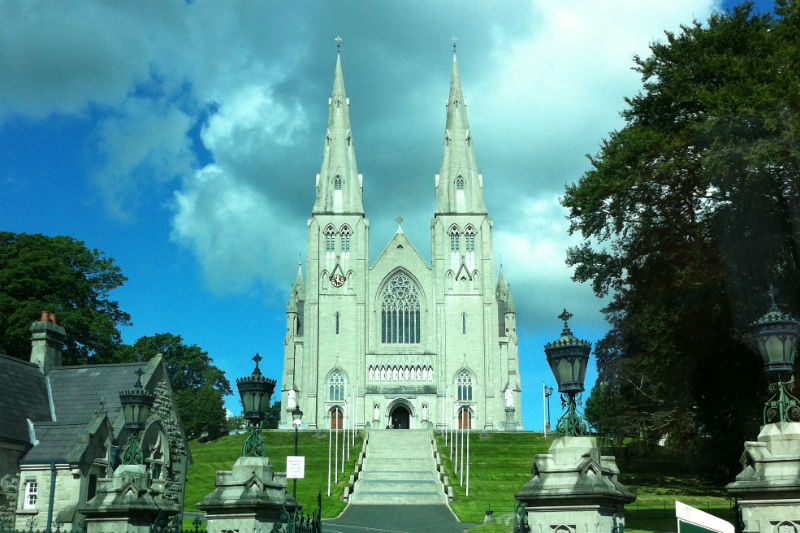 St. Patrick’s Cathedral in Armagh – Roman Catholic
St. Patrick’s Cathedral in Armagh – Roman Catholic
Armagh is also a city defined by twins linked to tragedy and triumph. Armagh comes from two Irish words that together mean the “Hill of Macha” or the “Height of Macha.”
Ard means hill or height and Macha is the name of an Ulster goddess who had super powers enabling her to run faster than any living creature. When she was pregnant and near delivery, her prideful husband boasted to the local king who was also prideful about his swift horses, that Macha could outrun them. The embarrassed king ordered Macha to prove it by racing his fastest horses in a competition staged in the presence of all of his friends.
Macha begged for mercy because she was heavily pregnant, but the king refused her pleas and forced her to run the race. Macha ran – and won. All, including the king were in awe of her strength. But at the end of the race Macha collapsed and died whilst giving birth to twins – a boy and a girl, one representing a blessing and the other a curse on the Ulstermen to last nine generations. The blessing was that Ulstermen would develop great strength and be the mightiest warriors in all the land. The curse was that at the times when they are in the greatest need, they would be stricken with the pains of childbirth and be incapacitated for five days and four nights. The boy went to sea (the otherworld) and met his mother and the other gods and goddesses. The girl stayed behind, motherless in a world that exploited and oppressed her kind.
Twin Cathedrals
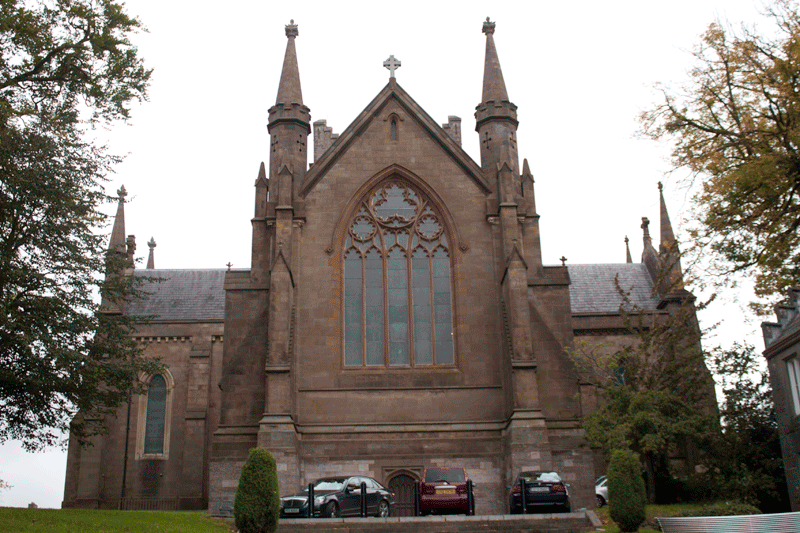 St. Patrick’s Cathedral (COI) in Armagh
St. Patrick’s Cathedral (COI) in Armagh
The twin pinnacles in the Armagh skyline are side-by-side hills each capped with a cathedral of two similar faiths. The two religions have a history of bloody conflict that goes back 700 years. They are the Catholics and the Protestants of Northern Ireland. Some say they mirror the ancient story of the twins of Macha, forced to be birthed violently because of pride, arrogance and greed. One allowed to be the warrior and the other oppressed with little power, forced into servitude. Triumph and tragedy. Blessing and curse.
But today’s Armagh shows few remnants of that conflict. People are warm and friendly, the downtown has nice shops and restaurants. It’s a busy town, but there are only scant traces of the brutal conflict that raged only a few decades. If I hadn’t been to Northern Ireland during the Troubles, I wouldn’t be able to measure the difference. But as a visiting American who traveled there both when the country was occupied and in recent years, I see the radical difference. Today there are no soldiers in the streets with machine guns, or crouching in alley ways, no razor wire, no moratorium on cameras and taking pictures, no tense people who don’t look up as you pass them on sidewalks – locals who provide no warm welcome for visitors… except for a few who were in the tourism business, and even they were guarded.
Armagh and the North – Good Times and Bad
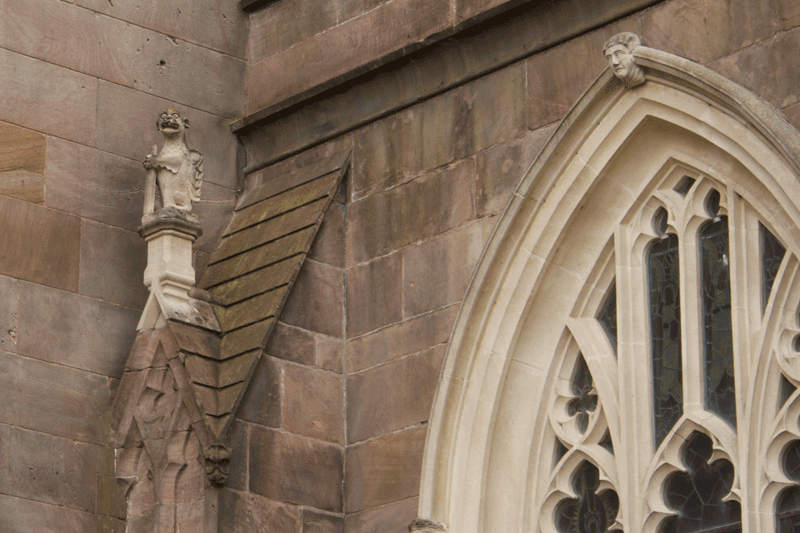 Gargoil on St. Patrick’s Cathedral in Armagh
Gargoil on St. Patrick’s Cathedral in Armagh
Don’t get me wrong. I loved Armagh then and I love it now as I love all of Northern Ireland. The only difference between the two time periods is that the curse is lifted. The two sides want to get along. They want peace. They want their children to be safe. They want to thrive economically and welcome visitors. Both sides know and always have known that they live in a magical land – a land of pristine beauty, a land of stories, a land of mystical energy. They’re eager to share their country’s treasures in the safe environment that has grown out of their commitment to peace. And visitors are very welcome.
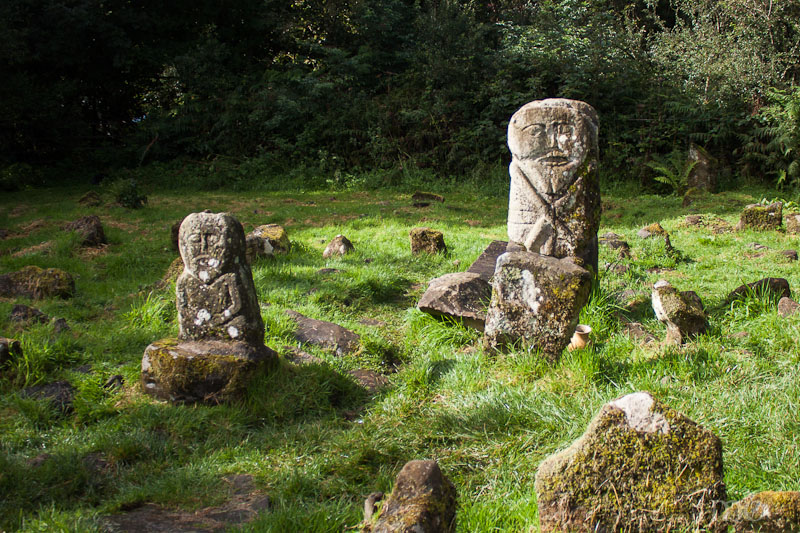 Janus figure – Caldragh Cemetery
Janus figure – Caldragh Cemetery
During all of the troubles and conflict, the ancient Janus figure still stood watch in that mystical cemetery named Caldragh in County Fermanagh. Saint Patrick’s Chair and holy well was still perched in the Altadaven Forest waiting for pilgrims to come forward and present their wishes. The sands of Whitepark Bay still sang in the wind. The stone circles at Beaghmore were still lying in wait in the shadow of the Sperrin Mountains ready to enchant the visitor looking for those spiritual ports in the storm that we call thin places. The North has always been beautiful and worth visiting, but it’s good to see the people of the North enjoying their land and each other.
Discover the North Tour
Both St. Patrick’s Cathedrals in Armagh are a part of our Discover the North tours as are St. Patrick’s Chair, Caldragh Cemetery, Beaghmore Stone Circles, Whitepark Bay and many other mystical sites.
Related Posts –
Padua House and Kathleen O’Hagan of Armagh
Armagh – Twin Symbols of Conflict and Unity
St. Patrick’s Chair – Make A Wish
The old County Tyrone legend states that if you sit in St. Patrick’s Chair located in the Altadaven Wood, and make a wish – that wish will come true within one year.
Mine did. But I’m not telling .. because you’re not supposed to tell. You’re supposed to keep it all to yourself.
This throne-like chair is carved out of one huge hunk of rock, and how it got placed so high on a cliff-like edge of the path through the woods is anyone’s guess. It’s been there for centuries.
Altadaven means “cliff of the demons.” It’s believed that this site, found deep in the thick forest surrounded by amazingly tall fir trees and hard woods with holly and ivy and fern lining the path, was once a meeting place for the druids. The legend tells of how St. Patrick came to this place and drove the demons (druids) “over the cliff.”
So what once was pagan became Christian. And what once was a center for druidic ritual became a center for prayer and Christian devotion. Today, tokens left behind at the site suggest both Christian and non-Christian people come as pilgrims to this powerful site.
There is a definite separation of energy at the entrance to Favour Royal Forest – as it used to be known. The entrance to the forest is a defined edge, with a keen sense of power. It’s a crossing, an opening into place with different energy.
The forest is thick and damp and the trees tall and slim with feathery leaves. The path is lined with ivy and fern. It is part of an old road called the Sliabh Beagh Way that runs across the countryside. It’s long been known as and enchanted road, and the forest around this part of the path is still referred to as the Fairy Green. It ascends to Pinnacle Rock which is where the Chair is.
I knew that we were on our way to see St. Patrick’s Chair because a friend brought me there. But I wonder how travelers would feel who didn’t know it was there – they were just walking this ancient path feeling the closeness of the trees and the energy around them… and then …. at the top of a rise they see this throne-like chair, six feet high, hewn from a boulder. And suddenly they know this is some special place. Some amazing place of resurrection.
From the chair there is a steep path leading down to another massive rock, this one with a small well carved out. There is water in the well and the path is lined with clooties and rags left behind by people who brought burdens to this holy well. They say the well never runs dry and that the water has healing properties. Others say the rock with the bullaun is covering an open chamber.
Tokens have been placed on the chair by pilgrims. Rosaries, holy cards, medals, statues, coins, a candle. The air is thick with wishes and dreams both recent and ancient. So many hopes are left to rest on St. Patrick’s Chair.
If you visit St. Patrick’s Chair, be sure to make your own wish. But don’t tell anyone.
The air around this place is charged with an energy that is no so gentle but more powerful, thick with presence. And the beauty of the forest is stunning. So much of Ireland is rock and open fields and rolling hills. A forest that one can easily walk through is a special to find.
If ever there was a portal into the world beyond this on, it would be here.
St. Patrick’s Chair and Holy Well are on the 2014 Discover the North Tour of Ireland.
7 Sites in Northern Ireland that Feed the Soul
I remember visiting Northern Ireland in the days when the military occupied the border equipped with machine guns and combat gear. I loved the north just as much then as I do now that the army, barbed wire and weapons are gone and a quiet peace has settled over the land. It’s a rugged, raw and ancient landscape that isn’t changed by external forces. Battles come and battle go, but the land and its sacred places remain unmoved and unchanged.
The North is my favorite region probably because the bones of the old landscape still peek through the sod without having to fight massive motorways and residential developments for attention. The ancients knew the energy was powerful here, and they marked many of their sacred places. While some markings have fallen away, the energy still lives. It continues to nourish the human spirit today just as it has for thousands of years.
Sadly, most tourists in the north pass by these special places not realizing that just off the road they’re driving on are stopping places where the traveler can walk in two worlds at once. Here are seven of my favorites in the North. You can’t approach this thin places and not be moved.
BEAGHMORE STONE CIRCLES – Co. Tyrone
I’m an earth energy novice. Like most common people, I can tell when a place has a sacred feel, but I can’t feel the energy move through the stones and emanate from earth the way some of my friends can. But Beaghmore radiates energy that even I can feel. It’s palpable.
Beaghmore is a series of seven stone circles set in a clearing at the edge of the Sperrin Mountains in County Tyrone. Six of of the circles are paired and one stands alone. The circles date back to 2000 BC. Artifacts excavated from the site suggest ritual activity 1000 years before that.
Two interesting things about Beaghmore – The circle that stands alone has 800 jagged stones set in the center (known as Dragon’s Teeth) and one circle has a portal to the Otherworld. In the center of the circle with the portal is a recent burn mark in the center of scorched grass and earth. It is currently being used as a ritual site.
Read more about the mystical nature of Beaghmore on Maura Brooks’ blog.
THE GIANT’S RING – Belfast
Belfast gets a ton of visitors. But how many know that just outside the city is henge monument that predates the pyramids of Egypt? A henge monument is a circular enclosure with a ditch carved out inside the ring. A henge fort is the same circular enclosure on the ditch is on the outside making it easier to defend the fort.
The Giant’s ring is a henge monument with the ring and ditch easily identified. The earth ring is about 600 feet in diameter and in the center is a slight hill crowned by a five large stones that support a large capstone. It’s believed that these stones on the hill are what remains of a neolithic passage tomb. The area is now preserved and used as a park. The visitor can do a ritual walk around the ring and then examine the stones in the center. There is actually a 3 mile defined walk of the ring and surrounds that includes a bridge that dates back to the Stone Age and a historic woodland.
There is a lovely energy here.
NAVAN FORT – Co. Armagh
I knew about Navan Fort being the legendary stronghold for the Knights of the Red Branch and the place where the goddess Macha died giving birth to her twins. Also known as “Eamhain Mhacha” or the “twins of Macha,” Navan Fort was associated with pagan ritual for years.
But what I didn’t know was that the famous mound (130 feet in diameter and about 20 feet high) had a fire ritual history. About 94 BC a wood temple supported by large oak pillars was built where the mound is and burned on the site in ritual fashion. The ruins of the temple were covered up with stone and earth creating the mound we see today. Excavation showed that soil used in the covering of the temple came from other places – some quite distant. Today people return to soak in the energy of the mound which apparently is still quite active. There is also a tradition of rolling down the mound to in order to soak in the energy of the mound whilst giving one’s own energy back to the mound.
At the base of the mound is a fairy tree, an old oak that looks much like a dragon rearing up against an enemy.
The story of Navan Fort is well told during the guided tour. For the full experience, pay the money at the Visitor’s Center and take the tour. The guides are fabulous and there is much to learn from them.
WHITEPARK BAY – Co. Antrim
Everyone knows about the great tourist sites on the Antrim Coast – the Giant’s Causeway, Dunluce Castle, Carrick-a-Rede Rope Bridge and the Bushmills Distillery. Travelers visiting these places pass right by Whitepark Bay not realizing what a mystical site they’re overlooking.
Right between the Causeway and Rope Bridge, just off the A2 is Whitepark Bay. It has a car park and solid stairway that descends to the magical beach where the sand sings.
True.
The sand on the beach is mixed with chalk from the cliff face which gives it such a fine consistency that when the wind blows a certain way (which it inevitably will) one can hear the sand “hum” with vibration. The cliffs are gorgeous and tucked into their vegetation overgrowth are the remains of passage tombs. This space in the landscape was considered sacred to the ancients. This beach is a thin place. It’s a portal, a threshold to the Otherworld. A place for thinking, for connection with your higher self. One only has to walk it to know this truth.
I collect heart shaped rocks when I travel as souvenirs from my twin granddaughters. This usually takes an hour or more to find the perfect rock shaped like a heart. At Whitepark I set out looking for two heart shaped rocks and asked my friend Maura to help thinking we could save time. Suddenly they were everywhere. Within 10 minutes we found 8.
8 … a mystical number for sure. The number that symbolizes infinity, connection to the Creator, the Cosmic Christ, the totality of the Universe. Maura kept one for herself. I brought 7 home. On sits on my desk. A daily reminder of Whitepark Bay.
GRIANÁN of AILEACH and the INISHOWEN PENINSULA – Co. Donegal
Driving the circle around the Inishowen Peninsula is at least a half-day, if not whole day commitment. But why not commit? It is some of the most spectacular driving in all of Ireland. And unlike many of the other spectacular drives (Ring of Kerry, Sally Gap, Connemara Hills, Molls Gap) it isn’t so crowded with visitors and coaches. Even in the cold and the pouring rain, the Inishowen is gorgeous. At its base on the south eastern side is Grianán of Aileach, also known as the Sun Palace.
Grianán of Aileach was the ancient royal site for northern Ui Néil from the 5th to the 12th century. The now restored cashel dates to the 3rd century and caps three concentric earth rings. The panoramic views from the cashel of the peninsula, Loughs Foil and Swilly and the city of Derry are dizzying – especially if you’re balancing yourself on the top ridge of the cashel.
There is also a tradition that the temple was built by Daghdha, the good god or god of the earth. He was known as the King of the Tuatha dé Danann, a race of supernatural beings descended from the Goddess Danu. They inhabited Ireland before the Celts. This tradition has Daghda building the fort to protect the grave of his son. A variation tells of giants building the hill and the Grianán on top a residence for the shining ones who gave birth to the children of the sídhe. All of these traditions link the hill and the fort on top with supernatural beings, to unseen energy and power and a link to the Otherworld.
BOA ISLAND & CALDRAGH CEMETERY – Co. Fermanagh
This is place every mystic should visit before he or she dies. Walking into Caldragh is like passing into another world. It’s an ancient cemetery on Boa Island set on the north shore of Lough Erne. It is surrounded by hazel woods with a fairy tree at the entrance. The ground is lumpy due to all the old graves, marked with jagged stones now covered by grass. There are also new graves but no church indicating this particular spot is still a place of sacred reverence for the local community.
Caldragh Cemetery is most famous for its Janus figure, a stone figure likely dating to the 4th or 5th century that has a face carved on both sides (thus the name Janus who was the Roman god of two faces). The Janus stands about 4 feet high and many archaeologists and mystics have guessed at what the two-faced figure represents, but it’s all speculation. There is a great energy in the stone. A dangling a pendulum above this stone spins quickly, even for the beginner. And the quiet soul will find a peaceful rest and easy connection to the Otherworld here.
Poet and Northern Ireland native, Seamus Heaney memorialized the Janus figure in a poem.
JANUARY GOD
Then I found a two faced stone
On burial ground,
God-eyed, sex-mouthed, it’s brain
A watery wound.
In the wet gap of the year,
Daubed with fresh lake mud,
I faltered near his power —-
January God.
Who broke the water, the hymen
With his great antlers —-
There reigned upon each ghost tine
His familiars,
The mothering earth, the stones
Taken by each wave,
The fleshy aftergrass, the bones
Subsoil in each grave.
For me Caldragh is much like the Rock of Cashel. No matter how many times I visit, I always want to return.
ALTADAVEN WOOD & ST. PATRICK’S CHAIR – Co. Tyrone
Altadaven Wood or Favour Royal Forest is an old wooded area bisected by an ancient road known as the Sliabh Beagh Way which snaked through Counties Tyrone, Fermanagh and Monaghan. On that road is the Demon Cliff where there is a large stone throne-like chair straddling a narrow space on the road. The chair, and the well below it are now known as St. Patrick’s Chair. Legends tell of this being an ancient druidic site that St. Patrick came upon while walking the Sliabh Beagh Way. When he saw the pagan ritual being performed he raised his crozier and cast the demons (druids) off the cliff and claimed the sacred site for Christ.
The forest is one of those great “edges” in the world where one crosses over into something upon entry. It’s thick and the mystical walk to the chair is deeply shaded by fir trees and lined with ivy, holly and fern. And suddenly you’re at the chair. Tokens left behind are reminders of other pilgrims who walk to the chair with intentions in their hearts. Some say that if you sit in the chair and make a wish, your wish will come true within one year unless you tell someone. It’s worth the walk.
All of the sites mentioned above are featured on our DISCOVER THE NORTH mystical tour of Ireland’s thin places.
Ardboe – Mystical Site on Enchanted Lough Neagh
ARDBOE or Ard Bó – a thin place in County Tyrone.
In Irish the name means Height of the Cow. The Ardboe high cross stands 18 feet high on the shores of Lough Neagh. It has 20 scenes from the Old Testament carved into its shaft that are still quite clear even after centuries of weathering out in the elements.
This and similar high crosses throughout Ireland were teaching tools used by the monks for religious education. In the early days of the Church, few villagers or farmers could read, so the bible scenes on the cross were used as a way to illustrate the lessons of the new Christian religion.
St. Colman founded a monastery in the 7th century on this site and built a church. The name Ardboe came from a legend that the mortar used to build that church came from a magic cow that emerged from the lough (Lough Neagh) that had gone dry. The milk from that cow gave strength to the builders as well as the building. In the 16th century, that old church built by St. Colman gave way to a new church – a church that still stands today as a crumbling ruin on the shores of Lough Neagh, clinging to that holy space, drawing its energy.
Lough Neagh is linked to enchantment, believed to be a dwelling place for the fairies. One of tales of Lough Neagh’s origin is that Finn MacCool, the famous Irish giant from Ulster, was chasing his arch-rival from Scotland and the rival was getting ahead of him. Finn MacCool reached down and scooped up a handful of dirt and stone and flung it at the fleeing Scottish giant, missing him by miles. The dirt and stone fell into the Irish Sea and became the Isle of Mann. The hole left in the ground from where Finn scooped up the dirt, became Lough Neagh. The Lough is now the largest freshwater lake in Ireland and Britain, covering 151 square miles and touching five of the six counties of Northern Ireland. For centuries people have believed that its waters have healing powers.
The energy around Ardboe is palpable. It is likely that the land where the monks of St. Colman built the church was already identified as a sacred site. When approaching Ardboe cross and church, one is called to be still. The entire landscape of water, grass, trees and stone is knitted together with a kind of oneness that clings to its past — even while sitting in the present.
To approach Ardboe is to walk into that time of St. Colman and the time of the people before him who also worshiped and prayed at this sacred, thin place. I’m not the only who has felt that special energy of Ardboe. My friend, Maura Brooks, a native of County Tyrone so believes in the mystical energy of Ardboe that she brings travelers to the site on a regular basis. It is Maura who introduced me to Ardboe, and she’s produced a short video about it that give some great commentary from a local perspective.
Irish writer, Polly Devlin, who grew up near Ardboe wrote about the Arboe church site in the 1950s…
The position of the small primitive group of holy buildings silhouetted against water and sky affects us, and most visitors, to initial stillness and silence. The crumbling arched windows frame the perpetual movement of the small crested waves of the lough.
Ardboe is a thin place. It is a stop on our Thin Places tour of Northern Ireland in Sept. 2018.
Boa Island and Caldragh Cemetery – the Janus Figure
This two faced Janus figure has been watching the sun rise and set over Boa Island for several thousand years. He’s about four feet high and is perched in a lumpy, ancient cemetery in County Fermanagh – Caldragh Cemetery.
Boa Island is a small island off the shores of Lough Erne, and Caldragh is a place of high earth energy. There is little known about this figure – referred to as the Janus figure because like “Janus” the Roman god with two faces, this figure has a front and …. well … a front. What you see in this image to the left is one side. The other side is also a front view with a face (see image below).
Locals found a piece of stone nearby that apparently used to serve as a base for this figure which would have made the Janus figure more life size when it was originally carved. No one knows exactly how old the figure is, or where it came from or what it means.
There is much speculation.
The Lusty Man
Near the Janus figure is a smaller, shorter figure that has a similar, sort of heart shaped face. But this little guy only has one face and appears to only have one eye – sort of blinded in his left eye. He is referred to as “the Lusty Man” ..not for any reason to do with lust or sensuality, but because he was found sitting all by his lonesome self in a marshy field on nearby Lusty Beg Island. He was relocated to Caldragh cemetery to keep him protected in a proper setting.
The two figures are anchors on this ancient burial ground. They stand above the ruts and lifts and random stones that mark now-forgotten dead. There is a remarkable presence in this untidy cemetery.
Caldragh is mystical
The cemetery has amazing energy that draws people to it, even though it is one of the hidden sacred places not often found in the guidebooks. If thin places are places where we are more in tune with God and eternal world, then Caldragh is paper thin.
Boa Island is one of several island in Lough Erne, but it is connected to the mainland by a a causeway and single road that runs from one end to the other. It is off this road that a marker sign subtly identifies the cemetery. The word caldragh was often assigned to Irish cemeteries that were not consecrated ground (by the Christians). These cemeteries were might be pagan, or places where unbaptized people or outsiders were buried. It certainly has that forgotten feel, but forgotten like a misplaced loved one, whose soul calls out to be found.
The moment a visitor steps into this space the energy vibrates. The Janus figure watches from every direction. Maura Brooks, a psychic medium and Reiki healer from Tyrone visited Caldragh Cemetery and used a pendulum to test the energy coming from the Janus figure and the Lusty Man. She writes …
Using a pendulum, the Janus figure swung anti clockwise, while the Lusty Man pulled it clockwise. (In energy terms, anti clockwise opens an energy, while clockwise direction closes it). Last time I was there, the cows in the nearby field starting mooing very loudly as I used the pendulum – almost as though they too, could feel the energy opening. And a large white feather fell out of the sky, even though there were no birds around.
Tracing the thin places path – “how did you get here?”
Thin places are places where we are more in-tune to God, the God of the Universe, the one loving creator that binds people of all faiths, all souls together into one connected family. Thin places lead us to truth, wisdom and purpose. But sometimes it’s hard to figure out what we’re supposed to learn of be led to.
Five steps for Traveling to Thin Places
Use these five keys for traveling to thin places. They unlock insights.
- Trace the route that brought you to the thin place. How did you get there? How did you hear about this place? Who led you there?
- Notice the signs as you enter. Sometimes things you see or encounter as you approach or enter a site will have meaning later.
- Take in the details. Look at the borders. Study with your five sense. Be still, don’t move. Just notice the details.
- Record your memories during or soon after the visit. In a journal write down the answers or notes from keys 1, 2, and 3. Also note how you feel, what you sense apart from your five senses. Write the date and time you were there. Record the names and details of key people you met or encountered at the site.
- Build your internal gateway at home. Store all related materials, notes, photos, mementos (items taken from the site) and anything else related to the site in one place. These items can help you return to that thin place internally when you want to revisit it and draw on the spiritual energy there.
May your spirit soar as you experience thin places.


